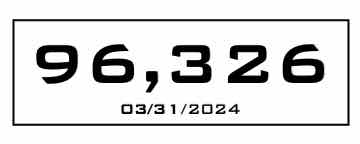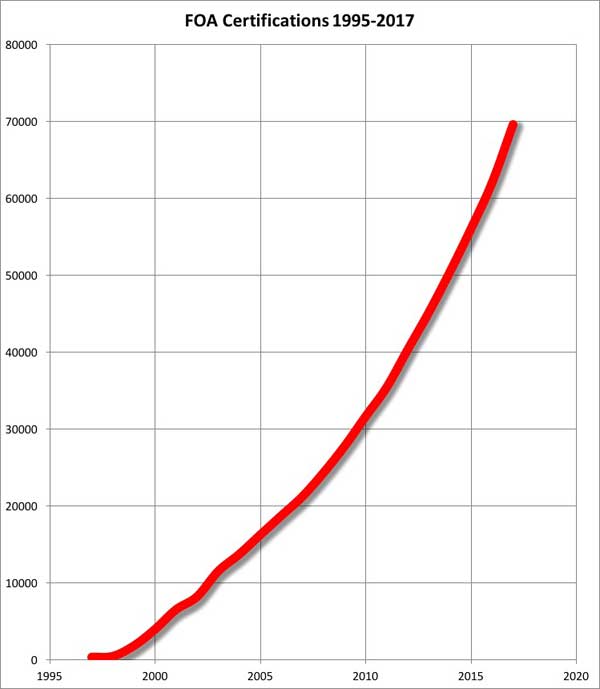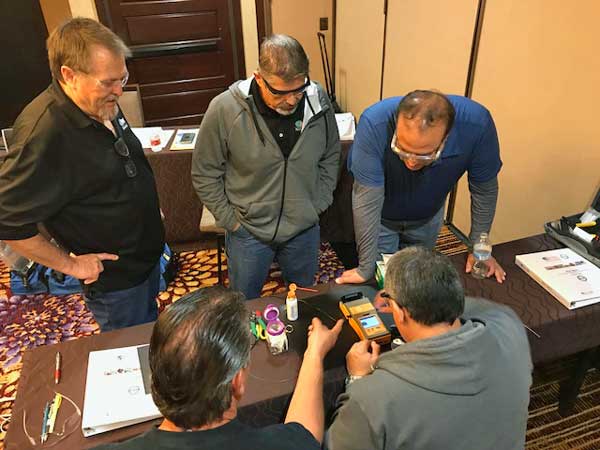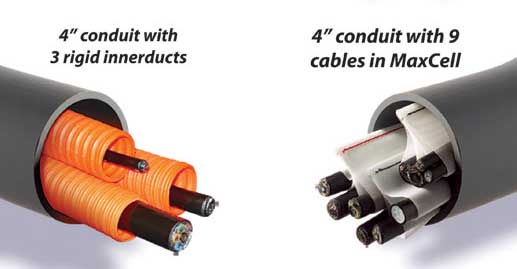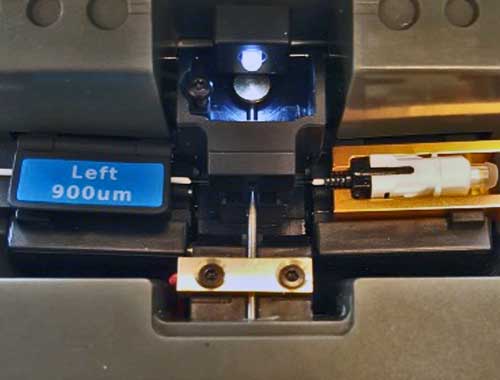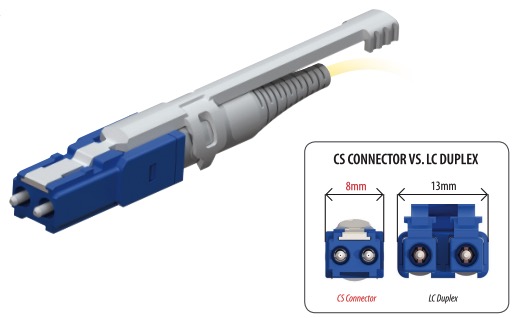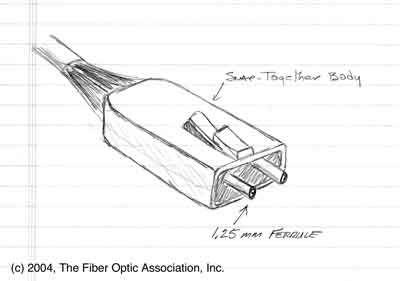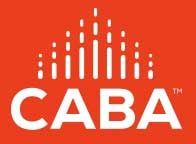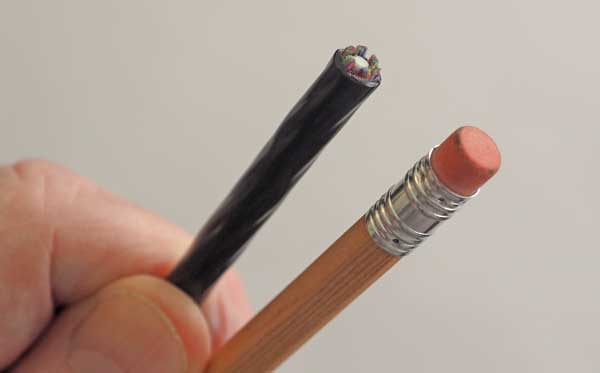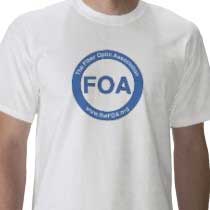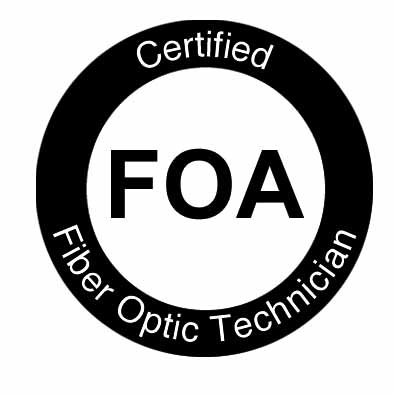The
Marketplace
The
fiber optic marketplace is incredibly healthy and growing.
That new technology we mentioned above is making design and
installation of new networks easier. More local groups
worldwide are taking matters into their own hands and building
fiber networks. The market outlook seems quite positive but,
maybe because we (JH) have tired of the all the hype not
followed by action, we must report:
Within
the fiber optic marketplace, we saw more of one thing than in
any year we can remember - HYPE. It was so bad that one person
we talked to described it as the year of "Fiber To The Press
Release." So much hype was floating around that we could start
a comedy channel on tech. For Instance:

Those hyping the IoT (Internet
of Things) want to sell you an Internet-connected toothbrush.
Internet
of Things: At the Consumer Electronics Show in Las Vegas,
one of the highlights was a toothbrush that would report to an
ap what teeth needed more brushing.That goes along with
refrigerators that track your food or a device that tracks you
wine purchases. Whenever we hear this kind of hype we point out
we were at a demo of an Internet-connected refrigerator at MIT
Media Labs over 20 years ago it it's still not accepted bu the
public.
The Washington
Post reporter covering the CES wrote: "Gadgets are
broken. That’s the refrain I heard on repeat from exhibitors
and long-time tech followers who also went on a dreary hunt
for big ideas at this year’s CES. There’s little reason to be
jealous of the 2018 crop of TVs, self-driving cars are a ways
off and artificial intelligence still has to mature. The best
moment at CES came Wednesday when the power went out for two
hours and folks had to go sit in the sun." Think about that -
all the IoT "pie in the sky" devices depends on power. When
the power runs out, your IoT devices don't work - even if they
are battery powered because in a short time the network goes
down - remember what happened in Puerto Rico last year? Are
you sure you want IoT connected locks on your front door at
home?
Self-Driving
Cars: Ready to trust them? Here is a photo of a Tesla
that just recently crashed into the rear of a Culver City, CA
fire engine stopped on a freeway. The Testa was on autopilot
doing 65mph. Amazingly, no one was hurt! The NY
Times ran an entire issue of the Sunday Magazine on
autonomous vehicles and if you are interested in this topic,
find a copy and read it.The most harrowing article was about
what could happen when 20% of the cars are autonomous - but
80% are not. And what happens when those with evil thoughts
try to subvert them. Also worth reading is this summary
of the status of self-driving cars by Marketplace on
NPR. Certainly this is a technology of the future and will
stimulate metro fiber deployment, but maybe not so fast as its
proponents claim.

5G
Cellular: 5G was one of the favorite topics for
speculation in 2017. Everywhere you turned there was an
article about 5G cellular. 5G wireless would have the
bandwidth to replace wired/fibered connections. 5G was just
around the corner. 5G would create a boom in the fiber market
because it required massive investment in fiber backbones (and
Corning emphasized that with commitments to Verizon for $1.3B
in fiber over the next couple of years.)
But then
Bloomberg
News published a report that conversion to a 5G network
was going to cost on the order of $200B per year in investment
and they concluded the cellular market could not support that.
Cell phone sales are flattening - markets are getting
saturated - and people are questioning the need for continual
upgrades. You cannot dismiss the technical issues regarding 5G
- how to get adequate distances at the ultra high frequencies,
problems with weather and the issue of cell
phone health/safety which has been raised again.
One must
wonder if the large telecommunications companies have a
problem with limited attention spans. They seemed to abandon
FTTH several years ago to focus on wireless and now seem to be
losing interest in 4G/LTE since 5G allows one to ignore
current problems and talk about "how great it's going to be!"
Sound familiar?
The
current cell phone networks need fixing. FOA gets dozens of
calls daily, the majority from cell phone users. The quality
of calls is terrible! You usually have trouble understanding
the caller and it seems a third or quarter of them end in
dropped calls. Wouldn't it seem reasonable to expect a service
as expensive as this would work? Remember some of us
want to actually use smart phones for communications -
something other than texting and watching YouTube, Netflix or
old TV reruns?
Are we
expected to pay upwards of $1000 for a mobile phone (the
prices are going up to that level) to not be able to use them
reliably? One would think that Apple, Samsung or other
smartphone manufacturers would get the idea that the network
they connect to is not providing adequate service and the
future sales of their devices is in jeopardy.
But
remember that Verizon Wireless committment to buy $1.3B of
fiber. It's going to be used developing small cells, which do
not depend on the development of 5G - 4G/LET technology works
just fine in the smaller areas covered by small cells. We can
walk around cities like LA, San Francisco and Santa Monica and
see the real fiber installation activity supporting small
cells.
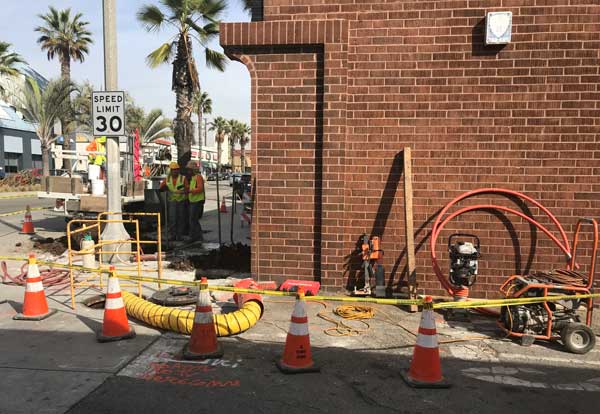
Crown
Castle installers installing a drop for a small cell in Santa
Monica, December 2017
The
5G Bombshell
This
month the US news was full of stories of a leaked National
Security Council proposal for the US Government to nationalize
the cellular networks and build a 5G network controlled by the
US Government. It was first reported by a politically-oriented
website Axios
and quickly spread all over the web. (Washington
Post, NY
Times) According to Axios,
" The memo argues that a strong 5G network is needed in order
to create a secure pathway for emerging technologies like
self-driving cars and virtual reality — and to combat Chinese
threats to America’s economic and cyber security."
In case
you missed it, this is the same administration that just
rescinded rules on net neutrality as government meddling. Is
the reason they want to do this tied to combating a threat
from China or is it something else?
What can
happen when the government controls the Internet.
Internet service in Egypt on January 27, 2011 was shut down
completely in hours.
Is it a
good idea to have a government control the entire cellular
network? Especially an administration that has been so critical
of news sources? Of course not, and of course such a proposal
shows how little knowledge they have of what it takes to develop
and build telecom networks. The response ignores the fact that
the US government has cut funding to research on projects like
this over the last few decades so all the knowledge base is
privately held. As for providing security against cyber attacks,
one must consider the number of security breaches in government
computer systems - 63
known new ones in 2017 involving 34million stolen records.
The immediate reaction to this proposal was confusion,
especially on the part of companies who currently own and
operate the US cellular network. Even members of the same
administration, including the people in the FCC behind killing
net neutrality, expressed opposition to the idea. Looks like we
can ignore this one!
Smart
Cities, The Internet, FTTH, Etc.
With the
big telecom service providers focused on wireless, it seems
local groups and cities are taking landline connectivity into
their own hands. There are probably more than a thousand
private metro metro and FTTH projects ongoing right now. FOA
gets calls weekly from new ones, with the most recent ones
being from a big city in the San Francisco Bay Area, a
rural town in CA and a - get this - a camping area with over
one-thousand lots in a rural Pacific Northwest community!
Google
Fiber is back doing some installations but with an
estimated few 100,000 subscribers, they are not a real factor
in connecting users. What they did do was make current ISPs
improve their service (and spend lots of money on lobbyists
and lawyers trying to stop them.) It's hard to evaluate
whether Google Fiber had a positive or negative influence on
the market - certainly they raised interest and expectation
but they caused a lot of legal barriers to local projects by
cities and utilities in many areas. Since Google (now parent
Alphabet) is famous for divesting "moonshots" we would not be
surprised to see this project sold someday.
The best
news is that metro/smart city builds are becoming more cost
effective. Components are getting cheaper, new installation
methods like we discussed above are become more accepted. The
understanding that if you want a small system you can build it
yourself has encouraged many new projects to get started.
We
recommend reading Black
& Veach's report on how data drives smart cities or
this Harvard
report on community owned fiber networks.
FOA's
Influence Grows, Makes News
FOA's
viewpoint has been quoted many times in the last year, on
topics as diverse ans installation processes, FTTH and data
centers. But we have one favorite.
FOA was
interviewed by McClatchy
news regarding the vulnerability of submarine cables and
the disruption of world Internet service. We pointed out that
there had been instances of cables being broken in the Middle
East, probably sabotage not accidents, and how it was not hard
to do. In addition the US is reputed to have a submarine
equipped to tap undersea fiber optic cables. The McClatchy
article received worldwide recognition, and a shortly
thereafter an article in the Washington Post titled "Russian
submarines are prowling around vital undersea cables. It’s
making NATO nervous."
The Final Comment

Making
New Year's Resolutions?
Do you make
New Year's resolutions each year? Why not add to the list
"Improving my knowledge of fiber optics." and take one of the
free online courses at Fiber
U? Want to know more about how fiber is used in data
centers, optical LANs, or the whole spectrum of wireless
applications. You can do that on Fiber
U. For only $20 (covers the testing service costs) you can
take the online Certification of Completion exam and get a
certificate for your wall. That certificate can be your ticket
to FOA Certification if you have the right experience. See the
FOA "Work-to-Cert"
program.
Dig
Safe Conference Next Month
The 2018
CGA 811 Excavation Safety Conference & Expo will be held
March 6-8
in Phoenix, Arizona. It is the premiere international event
dedicated to providing Telecommunications professionals with the
educational content and resources to help protect your buried
assets. With approximately 379,000 excavation damages in 2016
according to the Annual DIRT Report, there is certainly a lot
more that can be done to protect our nation's infrastructure.
Conference Sessions
Fiber Optic Asset Protection Summit
Workshops
Special Events
100+ Exhibitors Committed to Damage Prevention
More
Information Here.
FOA
Facts
FOA is a
non-profit professional society whose members are all certified
techs - mostly CFOT®s
-Certified Fiber Optic Technicians - but also may be CPCTs -
Certified Premises Cabling Technicians or corporate
members involved in fiber optics.
FOA is a "virtual organization" - we have no "brick and mortar"
presence. We operate over the Internet with operations centered
in California, with active workers and volunteers in locations
as diverse as Texas, Ohio, Canada, Singapore, Malaysia, Denmark,
South Africa, the Middle East and many more.
Being a virtual organization, FOA has very low overhead,
allowing us to offer cost-effective certifications and many free
programs to support our industry.
As of today, FOA has certified over 69,300 techs. About 90% come
from our schools but many experienced techs have become FOA
CFOT-certified directly through our "Work-to-Cert"
program.
FOA has almost 200 approved training organizations in about 40
countries around the world around the world.
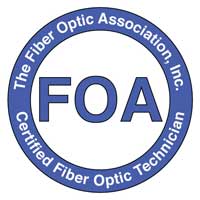
FOA has 14
fiber optic certification programs covering every aspect
of fiber optic network design, installation and operation.
Primary
Certifications: CFOT (basic fiber), CPCT (premises cabling),
CFOS/O (outside plant, taught with CFOT included) and CFOS/D
(fiber optic network design).
Skills Certifications (for installers and techs, requires
CFOT): CFOS/S (splicing), CFOS/C (connectors/termination),
CFOS/T (testing), CFOS/FC (fiber characterization).
Applications Certifications (for techs or anyone, including
managers and supervisors): FTTH (fiber to the home), CFOS/L
(optical LANs), CFOS/DC (data centers), CFOS/A (fiber to the
antenna), CFOS/DAS (distributed antenna systems) and CFOS/W
(fiber for wireless)

FOA monitors the trade press, websites and other
resources continually to look at what's happening in many
technologies that affect fiber optics. We're tracing
technologies as diverse as wireless, IoT, autonomous vehicles,
smart cities, energy, or anywhere fiber is used to bring news to
our readers.
FOA continually updates our technical materials, online and
printed, and our curriculum to ensure our readers have access to
the latest technical information and our schools teach the
latest technology and applications. Our printed books are being
updated right now.

FOA created the
FOA Online Guide as a non-commercial trustworthy technical
reference almost a decade ago so the industry would have a
reliable technical reference. In the last year, over 1million
visitors downloaded about 4 million pages of technical
information.
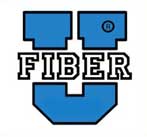
FOA offers free online self-study programs at Fiber
U. In 2017, the number of online sessions doubled to
200,000. Many of those are preparing for FOA certification
programs - taking courses at our schools or using the "Work-to-Cert"
program. Some of our schools are requiring Fiber U programs as
prerequisites for their classroom courses so they can spend more
time on hands-on activities.

FOA offers over 100 educational YouTube
videos that have been viewed 2.4 million times.
FOA offers its training programs to other organizations at no
cost to help them train their members properly in fiber optics.
For example, FOA has been working with the Electrical Training
Alliance (IBEW/NECA) for over 20 years, training their
instructors for their apprenticeship programs. We work with many
other organizations and companies to provide the materials they
need.
FOA has about 300 corporate
members - companies in various aspects of the fiber optic
industry worldwide that we list online and offer discounts on
certifications and renewals.
FOA provides speakers for many conferences and even
presentations for use by other organizations to educate people
on the aspects of fiber optic communications.
FOA has a program to provide classroom
materials for STEM
teachers (science, technology, engineering and math)
introducing K-12 students to fiber optics and creating science
projects.
FOA provides forums for discussion on various social media. Our
LinkedIn groups have about 5,000 members each. If you are not
joining us on social media yet, please do.





New
From FOA
New FOA
YouTube Video
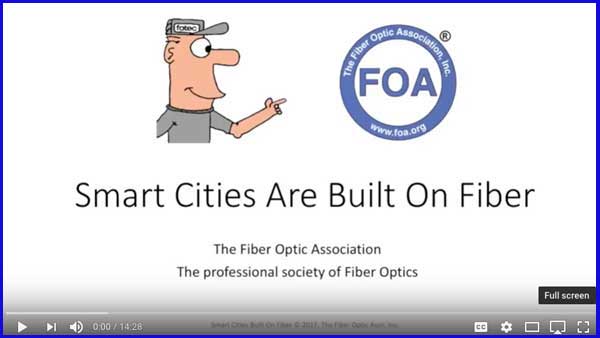
Everyone's talking about "Smart Cities" but what makes a city smart? It's a combination of services that will be delivered over an extensive fiber optic network. This video examines an advanced Smart City, Santa Monica, California, and looks the current services that make it a smart city today and what possible services can be delivered in a Smart City over fiber in the future.
Smart Cities Are Built On Fiber on YouTube
New FOA "Fiber For Wireless"
Curriculum And Certification

Fiber has become the critical part of the infrastructure for the
expansion of wireless communications. Just a few years ago,
fiber was used to connect cell sites to the telecom system and
backbones for enterprise LANs that were adding WiFi wireless
access points. Now mobile devices and demand for bandwidth are
driving major changes to these applications.
Today, we have LTE and 5G coming, RAN and Gigabit WiFi. We need
fiber backhaul to the traditional cell sites and up the tower to
the antennas, new architectures like fiber fronthaul or C-RAN
that support the traditional cell sites plus small cells and DAS
- distributed antenna systems inside buildings and campuses. We
have enterprise WiFi, metro WiFi and even rural WiFi being used
for broadband Internet. All depend on a fiber infrastructure to
deliver sufficient bandwidth to meet user demands.
FOA has created a “Fiber For Wireless” program to cover all
these applications (and define all the TLS - three letter
acronyms - so loved by tech industries!) We talked to managers
and technicians at telcos who are looking at all types of
wireless options, contractors who focus on wireless
infrastructure of all types, metro and utility personnel who use
all types of communications and of course manufacturers of these
new products.
Who’s
the audience? People who just want to know about the
intersection of these two modern, fast changing technologies.
The FOA “Fiber For Wireless” application specialist curriculum
and CFOS/W certification will give you the background you need
to understand the dynamics of today’s mobile applications and
prepare you to participate in those technologies. Look for it to
be available from select FOA schools and online at Fiber U in
the very near future.
Have
You Downloaded Your Copy Of The Updated ANSI/NECA/FOA Fiber
Optic Installation Standard Yet?
Available
Free Courtesy of FOA
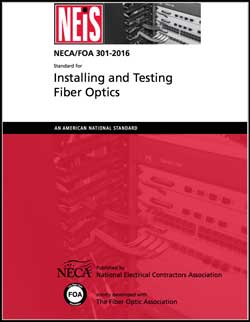
NECA/FOA-301was
created to be a document that could be used as a guide to
installation practices and also be quoted in project paperwork
to define what was meant by installation in a "neat and
workmanlike manner." This standard was the first standard to
approach the issues of installation of fiber optics in a
document that could be used by network owners, project
managers, contractors, installers, test techs, maintenance
personnel and even the manufacturers making the products being
installed following this standard.
Go
here for more information on NECA/FOA-301
and directions for a free download.
FOA's
Latest Textbook - Fiber Optic Testing
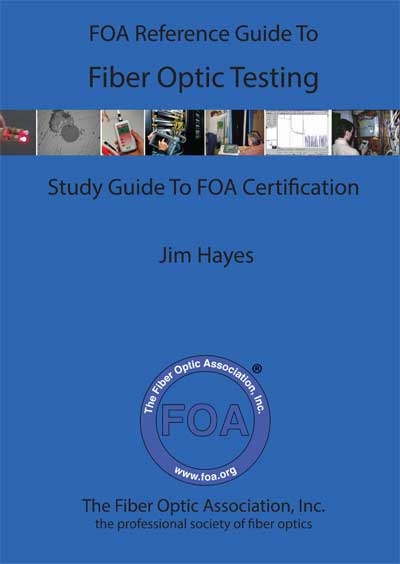
FOA
Reference Guide To Fiber Optic Testing
Libro
de Diseño para Redes de Fibra Óptica en
Español - FOA
Design Book Available In Spanish - Online
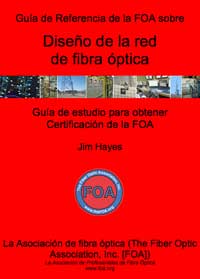
FOA has translated the FOA Guide To Fiber
Optic Network Design book and made it available online to
those studying for the CFOS/D Certification but whose native
language is Spanish. You
can access the Spanish translation of the Design book here.
A printed version will be available in the near future.
FOA
YouTube Videos Now "Closed Captioned"
FOA's
YouTube videos are very popular as you can see from the
statistics above. We have had requests from teachers and viewers
for closed-captioning. Now FOA is upgrading all its YouTube
Videos to offer "closed captioning" for those with hearing
disabilities - or if you want to view the video quietly and
don't have headphones. FOA used a highly-regarded service that
does closed-captioning for many of the television networks to
ensure accurate captioning.
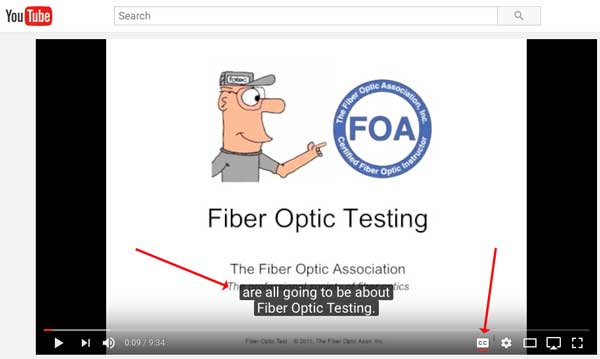
The closed captioning can be turned on by the small "CC" button
on the lower right side of the video (right arrow). The
captioning shows up on screen in white letters on a black
background (left arrow). You can view
this video on fiber optic testing here, and try the "CC"
button to see how it works.
We hope our viewers find this helpful.
FOA has over 100 YouTube videos on fiber optics, premises
cabling and the fiber optic job marketplace. Here
is a list with links to them online.
New
Website Keeps You Up To Date On Structured Cabling
Liz
Goldsmith, manager of the TIA Fiber Optic Technology Consortium
(FOTC) has started a new website that aims to keep readers up to
data on the news and products in the structured cabling
(premises cabling) space. Called Structured
Cabling News, it offers news about the industry in more
than a dozen categories so you can browse the news by categories
(like fiber) that interest you most. Liz sums up the aim of SCN
as "SCN brings you current Structured Cabling News curated by
category and topic. We search the 'Net so you don't have to -
updated daily with industry trends, new products and best
practice from industry leaders."
And you can subscribe to daily or weekly digests to keep
yourself informed.
Structured
Cabling News
Interested
In A Career In Fiber Optics?
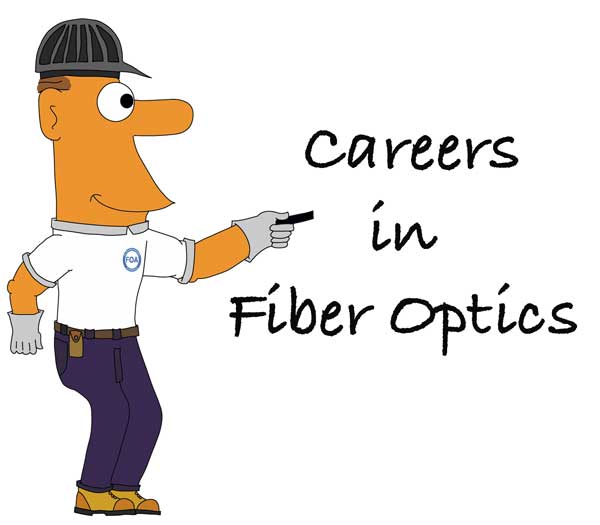
FOA has created a new YouTube video to introduce students to
careers in fiber optics. It was made for showing to high school
and junior high students interested in tech careers but anyone
interested in a possible career in this field will find it
interesting. If you have kids in school or know teachers, let
them know about this too. Watch the FOA
Careers In Fiber Optics Video on YouTube and visit the FOA
Careers In Fiber Optics web page at www.foa.org/careers/.
New
Viavi Database Illustrates More Than 500 Operational or
Planned Deployments Of Gigabit Broadband Globally
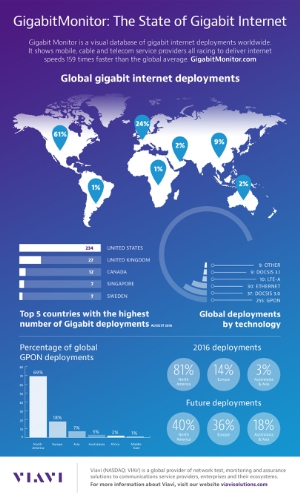
Communications service providers worldwide are accelerating
efforts to deliver gigabit internet -- network speed that is 159
times faster than the global average of 6.3 Mbps. The Gigabit
Monitor, a visual database referencing current and planned
gigabit deployments around the world, from Viavi Solutions (the
test equipement company formerly known as JDSU). The Gigabit
Monitor paints a picture of mobile, cable and telecom service
providers all racing to deliver lightning-fast internet
connectivity to meet end users' demands. The database, developed
completely from public information, is available at: http://www.gigabitmonitor.com.
Below are some of the key insights from the Gigabit Monitor:
- State
of gigabit: There are now at least 350 live gigabit
deployments globally, with a further 164 announced or under
construction, across wireline and wireless technologies
including GPON, DOCSIS 3.1, G.fast, LTE-A, 5G and 802.11ac.
- Contrasts
by region: North America has the largest share of announced
gigabit deployments, with 61 percent. Europe is second with
24 percent. Asia, Australasia, Middle East, Africa and South
America share the remaining 15 percent of deployments.
- Deployments
accelerate: The pace of gigabit deployments has accelerated
sharply. Over 70 percent of the live gigabit deployments
tracked have been launched since the start of 2015.
- Fiber
dominates: 85 percent of currently known gigabit deployments
are based on optical fiber connectivity. 11 percent are
based on Hybrid-fiber coax (HFC), a broadband technology
that combines optical fiber and coaxial cable, commonly
employed by cable providers.
- Wireless
gigabit is already here: Nearly 3 percent of known gigabit
deployments are based on LTE-A, a modified version of LTE
which is gigabit-capable.
- 5G is
coming fast: 37 wireless carriers have announced plans for
5G networks. Five of them plan to have 5G networks built as
early as 2017.

The word on
the "Dig Once" program is getting out - FOA is getting calls
from cities asking us for information and advice. It helps that
the current Administration is trying to convince cities of the
advantages of installing ducts or conduits when they dig up a
street so they don't have to do it again. Here are some links
for more information.
The DoT page on the administration’s Executive Order: http://www.fhwa.dot.gov/policy/otps/exeorder.cfm
From the Council of State governments: http://www.csg.org/pubs/capitolideas/enews/cs41_1.aspx
From the city of San Francisco: http://sfgov.org/dt/dig-once
An article about Dakota County, MN: https://muninetworks.org/tags/tags/dig-once
And
the one to download and hand out:
A “How To” Guide from The Global Connect Initiative: https://share.america.gov/wp-content/uploads/2016/04/6.-GCI-Dig-Once.pdf
Useful
Online Resources
We often
have contacts give us online links for useful information which
we like to share with our readers. Here are two:
Want To
Learn More About DIY FTTH?
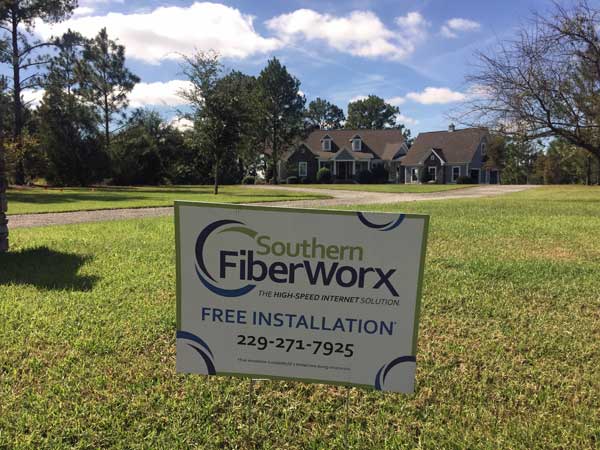 Southern
Fiberworx is a DIY FTTH Project in Georgia
Southern
Fiberworx is a DIY FTTH Project in Georgia
It seems
like every week FOA gets another call from a town, real estate
developer or utility wanting to start a FTTH project for their
area. FOA has created several videos and a a web page on this
topic to help anyone get started.
FTTH
Case Studies: Do-It-Yourself FTTH
FOA has a
series of videos on do it yourself (DIY) FTTH. The first three
videos are online now:
FOA
Lecture 45 Do It Yourself FTTH (Fiber to the Home) What's
involved in building a FTTH network of your own.
FOA
Lecture 46 Do It Yourself FTTH (Southern Fiberworx)
(FOA Newsletter
November 2015) How one company, Southern Fiberworx in
Cordele, GA did it themselves.
FOA
Lecture 46 Do It Yourself FTTH (Southern Fiberworx)
(FOA Newsletter
November 2015)
Why
We Warn You To Be Careful About Fiber Shards
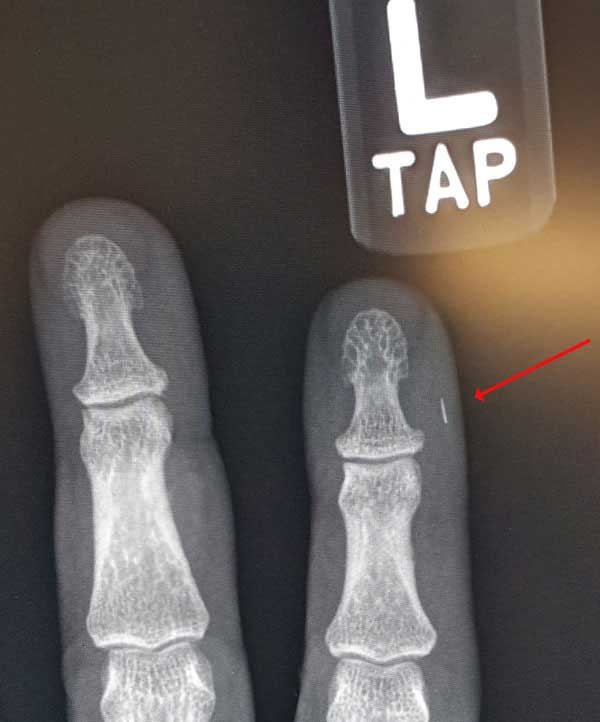
Photo courtesy Brian Brandstetter, Mississauga
Training Consultants
1-844-440-0047
www.fiberoptictraining.com
Another
Source Of Articles On Fiber
FOA
President and editor of this newsletter Jim Hayes has also been
writing a column in Electrical
Contractor Magazine for more than 15 years now. Electrical
contractors do lots of fiber work and this column has covered
some toics they are interested in including installation
processes, network design, fiber applications and in the last
year, a lengthy series on dark fiber - what it is, how's its
used and how it benefits the growth of communication. A recent
web site redesign makes it easier to browse all these articles -
just go to http://www.ecmag.com/contributing-authors/jim-hayes
and you can see all of them.
Fiber
Optic Education For Students At Any Age
We hear
about fiber optics all the time - it's in the news whenever we
hear articles about high tech, the Internet and communications,
and many communities are getting "fiber to the home." But few
people really understand fiber optics or how it works. FOA is
focused on educating the workforce that installs and operates
these fiber optic networks but we're always getting inquiries
from STEM (science, technology, engineering and math) teachers
who want to introduce fiber optics to younger students in K-12
grades or technical schools.
We
start with the FOA
Careers In Fiber Optics Video on YouTube and visit the FOA
Careers In Fiber Optics web page at www.foa.org/careers/.
These are for students who think they might be interested in
careers in fiber optics and want to know more about what fiber
techs do.
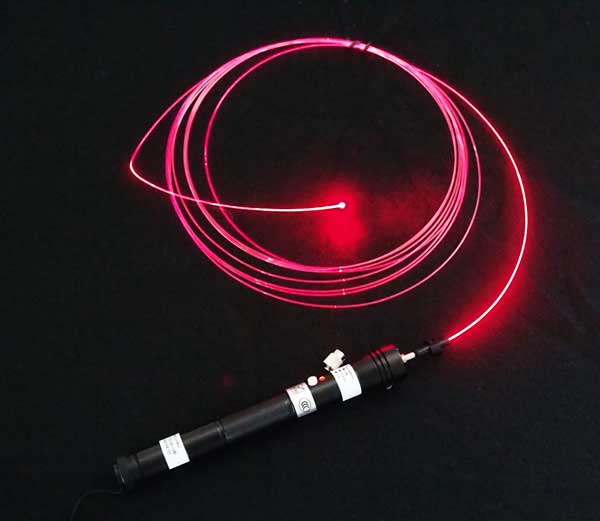
Using red laser light (a VFL here but a laser pointer works
also) to show how fiber guides light.
FOA has begun developing a series of YouTube videos intended for
teaching students in elementary, middle and high schools about
fiber optics. The first FOA video is titled "Fiber
Optics For Teachers." With this video, we show teachers
how fiber works and carries signals and then explains simple
experiments to demonstrate how fiber optics works in the
classroom using some plastic fiber and a laser pointer. Since
many teachers do not know where to get the fiber, the FOA offers
to send them a sample for use in demonstrations in their
classroom (USA only right now.)
At the end of the video, teachers are given directions on how to
request samples of the plastic fiber from the FOA.
This video joins the "Fiber Optics Live" series How
Light Travels In A Fiber, Fiber
Attenuation and Connector
Loss that show how fiber works using simple experiments
that can be duplicated in any classroom. More videos will be
coming soon.
If you have kids or know some teachers who would be interested,
please send them to the introductory video Fiber
Optics For Teachers and we'll be glad to help them
get started with some entertaining programs for their
classrooms.
Resources
For Teachers In K-12 And Technical Schools
Teachers in all grades can introduce their students to fiber
optic technology with some simple demonstrations. FOA has
created a page for STEM or STEAM (science, technology,
engineering, arts
and math) teachers with materials appropriate to their
classes. Fiber Optic
Resources For Teachers.
If
you have kids in school or know teachers who are interested,
send them to the FOA page Fiber
Optic Resources For Teachers.
Should
Your Company Become An FOA Corporate Member?
As all FOA
individual
members know, they join the FOA by becoming certified,
mostly taking their CFOTs but some CPCTs, either by
attending a FOA approved school or joining directly based on
field experience (our "work to cert" program.) Over the years,
we've been contacted by manufacturers, contractors, consultants,
and other types of organizations who ask about becoming members.
We don't certify companies or organizations, we told them, so we
were not sure what we could offer as a benefit of membership.
But then, companies asked about using our educational programs
to train employees, how they could get listed on the FOA website
as service providers or if they could get a quantity discount on
membership or certification for all the FOA members working for
them. That began to sound like a benefit for being an FOA
corporate member. And providing a list of useful suppliers to
the market could be a benefit to the industry as a whole.
So FOA has quietly been letting companies and other
organizations join the FOA to take advantage of those benefits
so we now have several hundred corporate members. We've put then
into a database and listed them on the FOA website in map
and list
form. Here's the map.
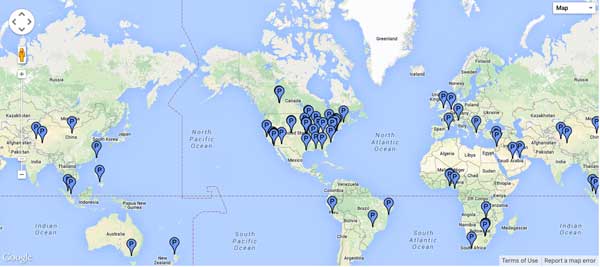
The online map
and list
can be used to find suppliers and service providers.
The map, like our map of schools, lets you find the FOA
corporate members close to you. The table form lists them
by category: Installer/Contractor, Component Manufacturer,
Installation Equip. Manufacturer, Transmission Equipment,
Services/Consulting, Distribution and Users of Fiber Optic
Networks. You can sort the tables to find members meeting your
needs, e.g. by location, certifications offered, etc. Click on
any column heading to sort that column; click twice to sort in
reverse order.
How
Does An Organization Become An FOA Corporate Member?
Simple,
just fill in the online
application form. When your application is accepted, you
will be asked to pay the membership fee - $100US first
year, $50US/year or $100US/3years to renew. You will then be
listed on the online
map
and list,
have access to exclusive FOA educational materials for your
employees and get discounts on certifications and
renewals.
Safety
On The Job


Safety is
the most important part of any job. Installers need to
understand the safety issues to be safe. An excellent guide to
analyzing job hazards is from OSHA, the US Occupational Safety
and Health Administration. Here
is a link to their guide for job hazard analysis.
FOA also has lots of information on safety: FOA
Guide, YouTube
video and a Safety
Poster
"Worth
Reading" Is Now On
Join
FOA on Pinterest.
We have been posting links to pages "Worth
Reading" on a special FOA Pinterest page. You can join and
keep up to date with the news on our industry which we put
there.
Recent
posts cover utilities using new generation telecom, India's
plan for 100 smart cities, Cincinnati Bell bets on fiber,
various opinions on the US battle over net neutrality, etc.
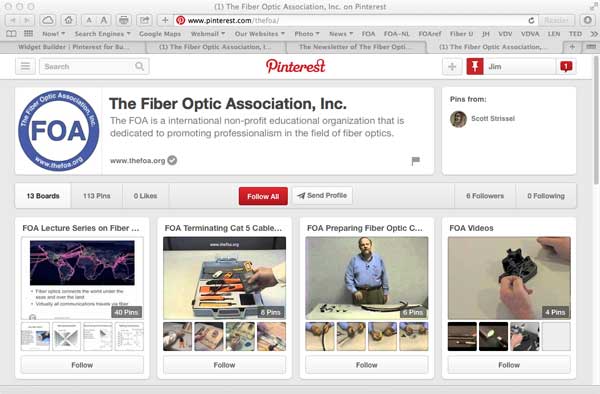
Good
Practice Tools For OTDRs, All Free
FOA
OTDR Simulator
You
may already know that the FOA has a free OTDR Simulator you can
download from our website (go
here for directions) that allows you to practice using an
OTDR on your PC (Win XP or 7), seeing the effects of changing
setup parameters and analyzing dozens of real world traces. But
here are two more tools that can be good for practice.
OTDR
FAQs
Including
more hints from FOA Master Instructor Terry O'Malley like tests
on what the end of a fiber trace looks like with broken and
cleaved fibers.
Frequently
Asked Questions On OTDRS And Hints On Their Use
"Fiberizer"
APP Reads, Analyzes OTDR Traces
Fiberizer
is a iPhone/iPad APP that reads industry-standard ".sor" format
files and allows trace analysis on your iPhone or iPad. An
android version is in the works too. Read
more about Fiberizer. And
here are more directions on its use.
Events of
Interest
FOA
now posts events on our LinkedIn groups, Facebook page and
other social media

FOA
has a company page and three LinkedIn Groups
FOA
- official company page on LinkedIn
FOA
- covers FOA, technology and jobs in the fiber optic marketplace
FOA
Fiber Optic Training - open to all, covers fiber optic
technology and training topics
Grupo
de La Asociación de Fibra Óptica FOA (Español)
RETURN
TO INDEX
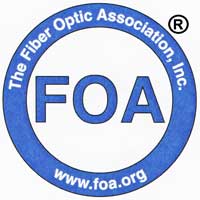 What's
Happening @ FOA What's
Happening @ FOA
FOA
Standards:
FOA now offers free standards for datalinks and testing the
installed fiber optic cable plant, patchcords and cable, optical
power from transmitters or at receivers and OTDR testing. Look
for the "1
PageStandard" web page and in the FOA Online Reference
Guide.
NECA/FOA
301 Fiber Optic Installation Standard
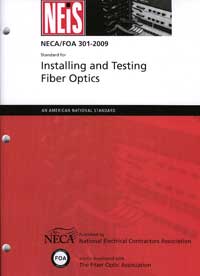
Standards
cover components and systems and how to test them, but rarely
get into installation issues. The FOA NECA 301 standard which
covers installation of optical fiber systems has been revised
for the second time, adding considerable new materials. This
standard is derived from FOA educational material put in
standards form and approved by ANSI as an American National
Standard. It's specifically written to be used in contracts to
define "installation in a neat and workmanlike manner." The
standard is available from NECA.
FOA members can go
here for instructions on how to download your free copy.
RETURN
TO INDEX
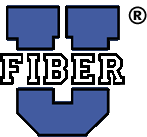
Free
Fiber U Self-Study Programs
FOA's
"Fiber U" free online self-study programs help you learn about
fiber optics, study for FOA certifications or use them to help
create "blended learning" classes. There are two new free online
self-study programs on Fiber
U. Fiber Optic Network Design is for those interested in
learning more about how to design fiber optic networks or
studying for the CFOS/D certification. FTTx is for those wanting
to know more about fiber to the "x" - curb, home, wireless, etc.
- or studying for the CFOS/H certification.
Got to Fiber U
for more information.
Fiber U
Online Self-Study Programs Offer Certificates of Completion
FOA has
been offering quite a few free online self-study programs on Fiber
U, our online learning site. We are always getting
questions about getting a certificate for completing the course
online, so we have setup an option to take a test online and get
a certificate of completion for these online courses.
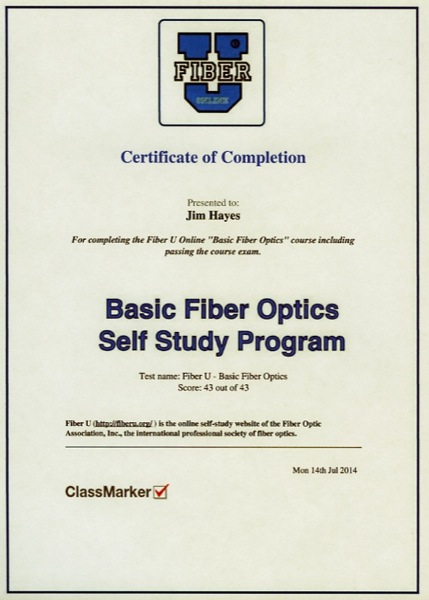
While it's not FOA certification, FOA will recognize a Fiber
U Certificate of Completion as background experience to
qualify for applying for FOA certifications. We also intend to
expand the program to more specialized topics as preparation
for FOA specialist certifications.
If you have associates that want to get started in fiber,
have them take this course online to get started. Go to Fiber
U and get started.
Lennie
& Uncle Ted Guides - Perfect For Getting Started
Lennie
and Uncle
Ted's Guides have moved to the FOA website.
Lennie is the place where many if not most fiber techs
begin their education. FOA has just updated the two
guides to ensure they stay relevant - more than 20 years
after they were first written.
Lennie goes all the way back to 1993 when he was created
as the mascot of the original "Fiber U" conference - the
same Fiber U that is now the FOA's web-based training
site. Lennie
Lightwave's Guide To Fiber Optics was created
as a beginner's introduction to fiber optics. Over
60,000 printed version of Lennie's Guide were given away
and it became one of the first commercial web pages in
1994. Uncle Ted's
Guide To Communications Cabling was written a
few years later to introduce techs to "Cat 5" - UTP
wiring - that had only recently been standardized in
TIA-568.
Lennie and Ted's Guides are used in the current Fiber U
online self-study programs and are still the best place
to start learning about fiber optics.
Lennie
and Uncle
Ted's Guides are online at the links here, can be
downloaded as printable PDFs and are now also available
as free iBooks on iTunes.
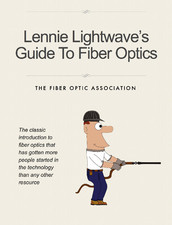
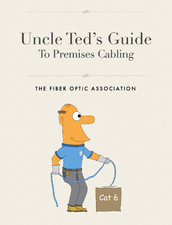
Lennie
Lightwave's Guide to Fiber Optics and
Uncle
Ted's Guide To Communications Cabling
are now available free to iPad users who can download them from
the Apple iTunes store. Of course they are still available
online or for download.
You can also find these free guides on the FOA website - go here
for all the links: Lennie
Lightwave's Guide to Fiber Optics and Uncle
Ted's Guide To Communications Cabling
 FOA
Reference Guide To Fiber Optic Testing FOA
Reference Guide To Fiber Optic Testing

FOA
Basic Fiber Optic Textbook Now Also Available in French
and Spanish
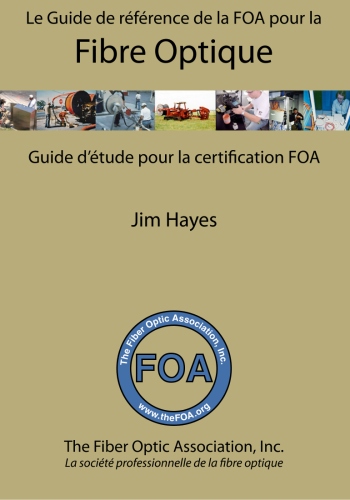
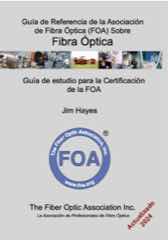
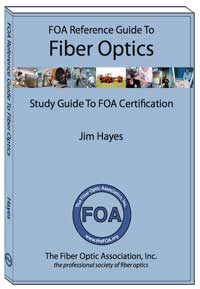
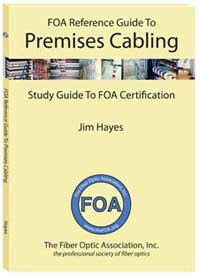
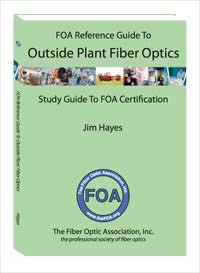
FOA
Reference Guide To Fiber Optic Network Design And FOA's
Outside Plant Fiber Optic Construction Guide
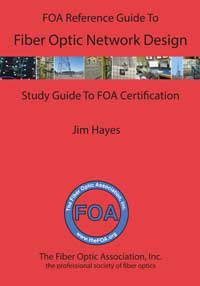
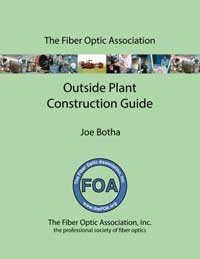
Read
More about the FOA
Reference Guide To Fiber Optic Network Design
and
More
information on the FOA
Outside Plant Fiber Optics Construction Guide
RETURN
TO INDEX
FOA
iPad Apps
FOA
LossCalc
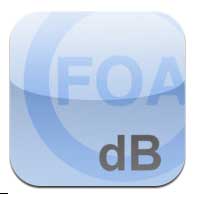 FOA
LossCalc estimates the optical loss of a fiber optic link. This
will save time for the installer of a fiber optic link needing
to know whether test results are reasonable and/or make a
"pass/fail" determination. It can also help the designer of a
link to determine if communications equipment will operate over
this link. FOA
LossCalc estimates the optical loss of a fiber optic link. This
will save time for the installer of a fiber optic link needing
to know whether test results are reasonable and/or make a
"pass/fail" determination. It can also help the designer of a
link to determine if communications equipment will operate over
this link.
By choosing the type of link (singlemode or multimode) and
specifying the length of the fiber and numbers of connections
and splices, it will calculate the end to end loss of the link.
The app has default specifications for singlemode and multimode
links or the user may create custom setups with specifications
appropriate for any application. http://itunes.apple.com/us/app/foa-losscalc/id476262894?mt=8&ls=1
Self -Study in Fiber Optics
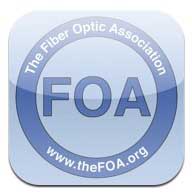 Our
first app is a self-study version of the FOA Reference Guide to
Fiber Optics. The FOA APP builds on the FOA basic fiber optic
textbook to create an interactive learning environment that
builds on the iBook electronic version of the book to add a
guide to use for self-study and real-time testing that provides
feedback on what you have learned and correct answers to
questions answered incorrectly. Our
first app is a self-study version of the FOA Reference Guide to
Fiber Optics. The FOA APP builds on the FOA basic fiber optic
textbook to create an interactive learning environment that
builds on the iBook electronic version of the book to add a
guide to use for self-study and real-time testing that provides
feedback on what you have learned and correct answers to
questions answered incorrectly.
The FOA APP is priced at only $9.99, same as the iBook, so the
self-study program is free. Download it from the Apple APP Store
with your iPad or iTunes.
http://itunes.apple.com/us/app/foa-guide/id434354283?mt=8&ign-mpt=uo%3D4
RETURN
TO INDEX

The
FOA has many videos on  ,
including two Lecture Series (Fiber Optics and Premises
Cabling), Hands-On lectures on both and some other informational
and instructional videos. For all the videos, go
to the FOA Channel "thefoainc" or use the direct links
below. ,
including two Lecture Series (Fiber Optics and Premises
Cabling), Hands-On lectures on both and some other informational
and instructional videos. For all the videos, go
to the FOA Channel "thefoainc" or use the direct links
below.
View
a complete list of FOA Videos with links to each video on
YouTube.
Where Are
The Jobs In Fiber Optics? FOA talks about all the
applications for fiber optics, what jobs involve and the
qualifications for the workers in the field.
Fiber
Optics - Live! A
series of videos that use lab demonstrations to show how
optical fiber works.
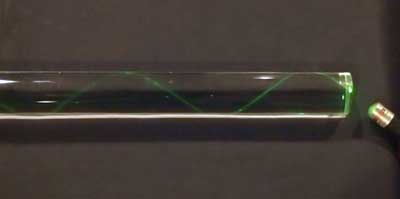
Cabling
Project Management - what's involved in a
copper/fiber/wireless project -advice for the customer and the
contractor
Hazards
Of Counterfeit Cable
You may
have read the stories we have written about the counterfeit
"Cat 5" cable made from copper-clad aluminum rather than pure
copper. Recently we tried an unscientific burn test on the
cable compared to a known good UL tested cable and posted a
video on YouTube. You can see the results below.
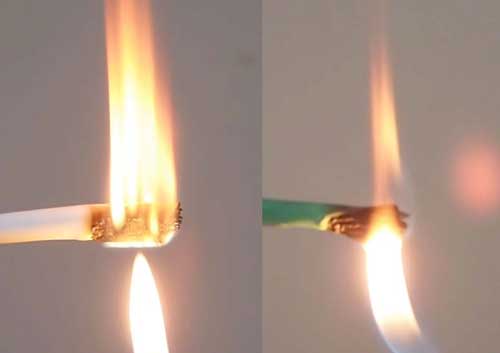
Counterfeit
Cable Real UL-rated cable
The
difference is obvious and the danger is real. Watch the video
on YouTube: Premises
Cabling Lecture 11: Counterfeit Cat 5 Cabling
View a
complete list of FOA Videos with links to each video on
YouTube.
View
all the FOA Channel on YouTube.
RETURN
TO INDEX

What's
New in the FOA Online Fiber Optic Reference Guide?
We are
continually updating the Online Reference Guide to keep up with
changes in the industry and adding lots of new pages of
technical information. Go to the FOA
Guide Table of Contents to see the latest updates - look
for  . .
Find
What You Want Using "Google Custom Search
 There's
so much information on the FOA Tech Topics and Online Fiber
Optic Reference Guide that even a well-organized Table of
Contents isn't enough and when the material is always changing,
an index is impossible to maintain. So the FOA is using the
latest technology in search, Google Custom Search, which will
allow you to search just the FOA Tech Topics and
Online Fiber Optic Reference Guide for any topic you want to
find more about. Try
it! There's
so much information on the FOA Tech Topics and Online Fiber
Optic Reference Guide that even a well-organized Table of
Contents isn't enough and when the material is always changing,
an index is impossible to maintain. So the FOA is using the
latest technology in search, Google Custom Search, which will
allow you to search just the FOA Tech Topics and
Online Fiber Optic Reference Guide for any topic you want to
find more about. Try
it!
Go
to The
FOA Online Fiber Optic Reference Guide.
RETURN
TO INDEX
New
Schools
The FOA welcomes the newest additions to our listing of FOA-Approved
Training Organizations:
The FOA network of training
organizations offering CFOT (and more) certifications continues
to expand. We welcome six new schools from quite different
backgrounds - a manufacturer, an electrical JATC and several
independent trainers.
Fiber
101, Port St. Lucie, FL, School #368
Find
a listing of all the FOA-Approved schools here.
Find
An FOA-Approved Training Organization
Most
inquiries we get regarding finding a FOA-Approved training
organization want to know two things: what school is closest to
me or what school offers the certifications I need. The FOA has
about 200 training organizations we have approved worldwide so
finding the right one can be difficult! We've been looking at
ways to make it easier, and we think we've got a good solution.
In fact we have two solutions.
First we have added a sortable
table of all the FOA-Approved schools.
You can also use our FOA
Google Map to find FOA-Approved schools.
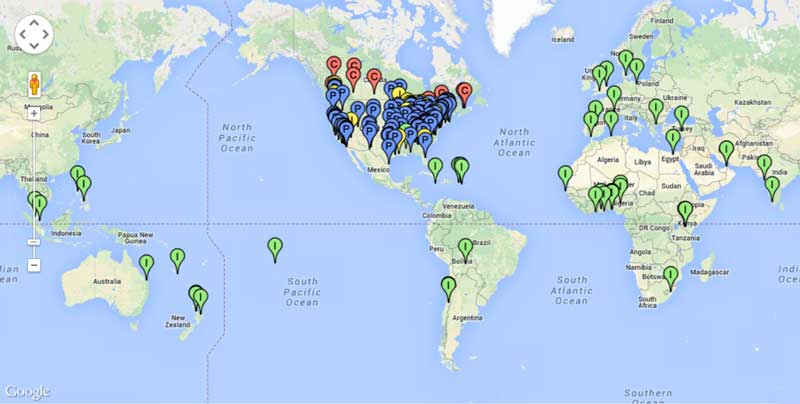
What
Should A Fiber Optics or Cabling Tech Know and What Skills Do
They Need?
FOA
certifications are based on our KSAs - the Knowledge, Skills and
Abilities that techs need to succeed. Read the FOA KSAs
for fiber and cabling techs.
School News
Feedback
We always
enjoy feedback, especially when it shows how great some FOA
instructors are. These came from students of Tom Rauch, an
instructor at BDI
Datalynk:
"I took your fiber optics certification courses this past March.
I just wanted to let you know that in two weeks I start working
as a fiber optic technician with ___ up in ___. You mentioned on
the first day of the course that there is always one guy in
class who had rubbed his last two nickels together to be there
and, in that instance, I was that guy. Now I'm going to be able
to provide for my family like never before and I owe it to the
certification that I received from you and BDI Datalynk. I just
wanted to thank you again."
"Thanks to our tremendously knowledgeable and patient instructor
Thomas Rauch, who was not only generous in sharing his wealth of
information, but he did so with ease, humor and in a way that
invited curiosity and participation. He was encouraging and
proud of our accomplishments and helped us learn from our
mistakes in a way that did not break our confidence, rather it
pushed us to better results the next go around. The hands on
labs were just AWESOME!" Just thought you should know what a
class act you have representing you in his travels..... but then
again you probably already knew that! : )
In almost 19 years at Verizon and having held numerous
positions, I have gone through many training sessions. I cannot
remember ever having been actually looking forward to coming
back to class quickly after lunch, to get back to the hands on
activities, and walking away with the sense of empowerment that
the information presented was not only relevant but dead on
point accurate! I will be signing up for the Outside Plant class
on March! I can't say enough good things about Tom and his
impact! Feel free to quote me, I can only imagine that he will
open so many doors and change so many lives in the years to
come, with his style of teaching! Great experience, awesome job!"
IBEW
and FOA Partner on Fiber Optic Training
The
International Brotherhood of Electrical Workers (IBEW) and the
National Electrical Contractors Association(NECA) through the
National Joint Apprenticeship and Training Committee
(NJATC) in
a partnership with the FOA has published a new textbook for
training IBEW apprentices and journeymen in fiber optics. The
new textbook uses the material from the FOA Reference Guide To
Fiber Optics with new material and photos from other NJATC
training partners.
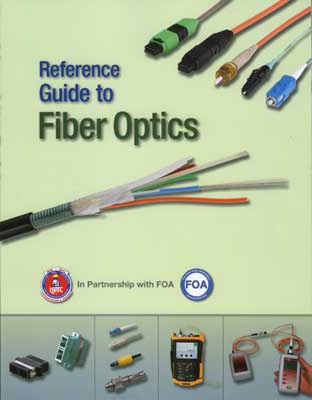
Quote
from one of our certified instructors: I want to thank
you and your organization for all the resources you provide for
the students and the opportunity to offer the certification to
the students. The fact that you published the book yourself to
get the cost down and the unlimited free resources on your
website shows a commitment to the public that is second to none.
I let it be known to the students that the FOA is the best in
the industry at supplying knowledge and resources related to the
communication industry. I look forward to passing on the
information that you provide for the industry.
RETURN
TO INDEX
Good
Question! Tech Questions/Comments Worth Repeating
Real
Questions From FOA Newsletter Readers
Negative Loss?
Q: We
were sent this OTDR trace and asked why some traces showed
negative loss - gains.

A: The
issue with this OTDR test of a factory-manufactured patchcord
was not straightforward. To summarize, the patchcord was plugged
directly into the OTDR port, with no launch cable. The OTDR has
no reference for measuring the loss of the first connector on
the cable nor the second connector since neither launch or
receive cables were used. Without a launch cable, the OTDR is
trying to get information from the connection to the instrument
itself which is basically impossible since it’s suffering from
overload caused by the test pulse - even with APC connectors.
The OTDR (Yokogawa) is one of the cleanest OTDRs at the
interface (we have one on loan at FOA right now) but it’s still
not designed to measure that loss. Furthermore, using the
instrument interface to plug in every connector will wear that
connector in the unit out quickly and require servicing by the
factory. The second issue is the difficulty of measuring on
short cables like this. Note the vertical digital resolution of
the display and think about the location of the second marker -
it’s measured dB value will jump around as it goes from digital
segment to the next digital segment. When you use a launch cable
and measure the loss of the connectors using the “4-point”
measurement - also called “least squares approximation” in the
FOA Guide to OTDRs. That will overcome the digitization errors
as well as the settling times of the pulses.
POTS over Fiber
Q: I would like to know if there is information on your
website that explains "POTS OVER FIBER"?
A: POTS - the acronym for “plain old telephone service” -
is digitized to transmit over fiber. In the early days (late 70s
and 80s) it was simply T-carrier with a fiber converter. By the
end of hte 80s it was ATM and SONET. More recently, it’s all
going to carrier Ethernet since 99%+ of the traffic is data not
voice or PONs (passive optical networks) for fiber to the home.
Re-routing Old Fiber Optic Cables
Q; I have a questions about the re-routing of fiber optic
lines that have been in place for a number of years. Is it
a standard transaction in the fiber optic business to have to
re-route fiber that has been in service for a long period of
time. (e.g. >20 years) If so, is there a best
practice for removal from conduit for re-rerouting?
A; There is no way we would recommend removing and
reinstalling 20-year old fiber cable. First of all, old cable
may be damaged in removal. Then cable and fiber technology has
improved over the years so you can get much better components
today at greatly lower prices. (One industry analyst I know
likes to say that fiber is cheaper than kite string and fishing
line!) Today’s cable designs allow for much smaller cables with
many more fibers (288 fibers in 9.7mm - just over 3/8”) and new
conduit designs allow for more cables in a conduit (microducts
and cloth ducts) and easier installation - blowing in cables and
microtrenching are perfect for metro areas.
More fibers, especially in a big city, is a must. Smart cities,
small cells, FTTH (fiber to the home), ITS (intelligent traffic
systems), V2X (vehicle to vehicle, infrastructure, etc.) and
many other services need lots of fibers.
Our recommendation is to pull it out and dump it. Install new
ducts and the fiber you need (x10 maybe?) and have new ducts for
future use. Are you familiar with “Dig Once”?
APC Connectors On Power Meters
Q: We need to test a fibre link terminated with APC SC
pigtails. I am using SC-APC Ref Leads to interface the LSPM to
the fibre link. I am using the 1 Test Cord Method. Step 1 means
connecting the LS to the PM via one Ref Lead. That means I have
an APC Green SC connector plugged into the PM. Is that
OK?
A:The SC APC connector should only be mated to another SC
APC connector to prevent potential damage to the fiber/ferrule
end. But most power meters have adapters for the connector that
have an air gap above the detector to prevent contact to the
detector window. Plus, the detector should be large enough to
capture the light from the SM fiber exiting at a small angle.
Thus you can plug the connector into the power meter directly.
Some meter manufacturers make SC APC adapters for their power
meters that angle the connector toward the detector but that is
generally not necessary unless the meter has a very small
detector.
However if the power meter has a pigtailed detector - that is
the meter has a fiber>fiber interface, you will need to add
an adapter patchcord to mate the APC connector to it. When you
set a 0dB loss reference all those connections will be zeroed
out.
Directional
Testing
Q: I have taught for several institutions and throughout
all my years of doing this I was always taught that when testing
for insertion loss and back reflection for singlemode cable
links that testing bi-directional is an imperative.
Recently when I was attending a meeting involving members of the
military along with folks involved in the development of the
military manuals, it was mentioned that with singlemode testing
that bi-directional testing is not necessary.
A; First of all, there is a directional difference in
splice or connector loss - and maybe reflectance (that term is
now almost universally used in place of “back reflectance” which
is a poor term since a reflection is always back) - as long as
two different fibers are being spliced. Fiber geometry is the
main difference - mode field diameter in SM and core diameter in
MM - but it can also be a matter of the fiber composition.This
happens if two different manufacturers’ fibers are joined or
bend-insensitive (BI) fiber with differences in depresssed
cladding geometry are joined.
If you test bidirectionally with sufficient accuracy, you can
see the difference. It’s an OTDR trace that most people are
familiar with - if you see a gainer, you shoot the
other direction and average to get the “actual” splice loss.
When splicing or connecting different types or manufacturers SM
fiber you may see directional differences of up to 0.3dB or
more. Same for MM, not only for differences in core diameter but
also for connecting BI to non-BI fibers. While those OTDR
measurements are actually differences in backscatter levels,
they are indicative of real differences in connector loss or
splice loss in opposite directions.
Are those differences enough to be of concern? That’s a judgment
call.
We’ve found most people do their bidirectional testing all
wrong. With an OTDR, you should disconnect the instrument, not
your launch and receive cables, and take just the instrument to
the other end. Disconnecting the launch and receive cables
changes the fibers at the connections to the cable under test
and you lose the connection you want to test from the opposite
direction.
Bidirectional testing with a test source and power meter is more
confusing. You have to do your “0 dB” reference, check the
launch and receive reference cables, measure the cable under
test, then move just the source and meter to the other end, test
the cable under test again, then disconnect and then measure the
output of the source to get the “0 dB” reference used in that
direction. That’s confusing!
Even if you do test bidirectionally, you do not get the “actual”
connection or splice loss like everybody says - you get the
average of the two directions. Unless you are willing to do a
lab setup and some careful testing, that’s the best you can do.
Now we are into measurement uncertainty. If the measurement
uncertainty is around the same as the typical bidirectional
difference, does bidirectional testing gain you that much?
That’s a judgement call.
The new FOA book on
testing goes into this - a complete chapter is devoted to
measurement uncertainty.

When To Test Fiber
Q: Should testing of the fiber plant be done before the
Optical Network Terminal is installed?
A: Fiber optic testing is generally done when the cable
plant is installed to confirm proper installation and check that
the performance is adquate for the electronics planned for use
on it.
There are several processes - first an overview of testing:
Check cable before installing - continuity if it looks OK, OTDR
testing if the reel is damages
Test installed cable when splicing - check the fusion splicer
estimate of loss and do OTDR testing if questionable and inspect
every connector as termination is done to confirm the connector
is good.
Test cable plant after splicing and termination - end-to-end
insertion loss and OTDR testing for longer OSP (outside plant)
links.
New singlemode cable plants for high speeds may need "fiber
characterization” - adding in CD (chromatic dispersion), PMD
(polarization mode dispersion) and SA (spectral attenuation for
DWDM wavelengths) testing. If one is considering upgrading a
cable plant that is already installed or has been used, these
same tests should be done - inspection/cleaning, insertion loss,
OTDR.
When the system is installed, one should know it should work
because of the testing done during installation. One should
inspect and clean patchcords before installation and test them
if suspect. In fact any connector needs inspection/cleaning
before hooking up equipment. Dirt is the biggest problem with
fiber optic systems.
Differences
Between Singlemode or Multimode Mating Adapters
Q: What is the difference between singlemode and multimode
bulkhead/adapters (mating adapters). My understanding is you
cannot use the singlemode with the multimode and visa versa.
A: There are 3 types of adapters - rated for SM or MM -
based on the alignment sleeve material.
-Plastic (glass filled thermoplastic) alignment sleeves are
cheap, not very precise and wear quickly (you can see ceramic
ferrules get dirty using them) - only good for multimode and one
or two insertions - not recommended
-Metal (phosphor bronze) alignment sleeves are better with good
alignment but still wear some - OK for MM, some are rated for
singlemode (check before you buy), and are OK for most uses but
will wear out if used for repetitive testing
-Ceramic alignment sleeves are the best and most expensive. They
are very precise in alignment and last for a long time.
Recommended for all singlemode and all testing purposes.
Don’t use MM adapters for SM but SM adapters are OK for MM.
Why A Figure 8?
Q: What is the reason for wrapping the cable in a figure
eight?
A: When you need to do an intermediate pull, you have to
pull the fiber and coil it on the ground. A simple coil will put
a twist in the cable. Figure-8 coils put in twists of opposite
directions on each side of the 8 making for no overall twist in
the cable. See How
To "Figure 8" Cable For Intermediate Pulls in the FOA
Online Guide.
Can I Build A GPON Network With "Taps"?
Q: Can I build a GPON network where I do a drop to one
subscriber then continue to the next subscriber for another drop
and so on?
A: There have been examples of this type of “tap” drop proposed,
for example in rural areas for drops to widespread
subscribers on a longer network than is typical for FTTH. It’s
just a version of a cascaded splitter network. with taps that
just do a 2 way split. The taps used are typically 90/10 taps,
where 10% of the power is tapped off for the drop.
There are some important issues to consider - Since you are
dropping 10% of the power at each tap, you are limited by how
many drops you can have. If you calculate the loss
budget - after the first tap, you have 90% power left less the
excess loss of the splitter (~0.3-0.5dB). The tap power is down
~10.3 dB and the through power is down ~0.6 dB. At the next tap,
you use the same formula plus you add the loss of the
fiber to that tap and so on until you reach the GPON
limit. It’s a pretty complicated process to design, but
you can see that with these power losses you will not get a
large number of drops in a GPON network with 28dB max power
budget. We did a rough calculation and 20-24 drops may be
possible depending on the fiber lengths.
This network will probably be much more expensive and more
distance limited than simply running a cable with many fibers
and dropping fibers from that cable with midspan entry. Couplers
are expensive, fiber is cheap. We also do not know the issues
with the large differences in transmission times between the
first connections and the last ones, which depends on the length
of fiber in the systems. That may require some programming at
the OLT.
Replacing
OM1 MM Fiber
Q: We are an automation system integrator in South Africa. We
have a client that has multimode 62.5/125 fibre optic plant
wide. None of the runs between components are longer than 2km.
We intend to upgrade the technology from a proprietary
communication protocol to a standard ethernet protocol at 100
MHZ. The fibre to copper convertors we will be using are using
1300nm light source and have a Fibre Optic Link Budget of 12.8dB
for 62.5/125 um and 9.8dB for 50/125 um. The client has been
advised to replace the multimode 62.5/125 with multimode 50/125
cabling and we need to know if this is really a requirement.
A: Do you know how old the fiber is? It should be what we called
FDDI grade 62.5/125 fiber with a loss of ~1dB/km and a bandwidth
of 500MHz-km at 1300nm. A 2km link should have a loss of 2dB for
the fiber and ~0.5dB/connection - well under the power budget of
the link. 100Mb/s Ethernet variants were designed for 2km or
more on this fiber. There is no reason to upgrade at this time,
50/125 fiber would not be needed until Gigabit Ethernet was
desired.
Do We Need Repeaters For 30 Mile Link?
Q: I need to design a 30 mile (~50km) link. Will regeneration
like a fiber amplifier be necessary?
A: It depends on the comms equipment but I doubt you need
regeneration. 30 miles is 50km, only 10dB of loss for the fiber
at 1550nm, maybe 10 splices at <0.1dB adds only 1dB loss and
another dB for connectors on each end. I think you probably can
find equipment that runs on 12dB loss budget. That said, most
new high speed systems (>10G) have 20km versions then go to
expensive long haul coherent systems. So talk to the
communications equipment manufacturers and see what they say. If
you do need a EDFA, they are not that expensive but the site is
expensive and requires power (+ backup). See if it’s possible to
put the EDFA in the end facilities to get enough power for the
whole run.
Testing PCS Fiber
We Get Many Questions From Our Instructors Also
Q: I recently did a CFOT
training class for a government agency. They use 200
micron core fiber in short sections (50 ft. the longest) within
aircraft. The connectors are SMA 905s. The cable specs
state that there is 8dB of loss in 1 km at 850nm. I have
searched but cannot find any info regarding how to test the
cable/connector links. The OLTS they have uses 62.5/125
jumpers. Is testing these cables with the above OLTS setup at
850 nm a valid testing method?
A: That’s 200/240 PCS or HCS fiber - plastic clad silica or hard
clad silica step-index fiber - that has a glass core and plastic
cladding. It has been used on a lot of platforms because it’s
large core makes connection alignment easy. The SMAs are used
because the connectors are air gap connections so vibration will
not cause scuffing that you can get with PC - physical contact
connectors. On aircraft, the 1/4-36 nuts on the SMAs are usually
safety-wired too.
Testing can be done just like any other cable plant with a
double-ended test (OFSTP-14) for the whole cable or a
single-ended test (FOTP-171) to check the connection on either
end. You need a 850nm LED source and a meter with a large
detector (>2mm) to pick up all the light and an adapter for
SMA connectors. You also need launch and receive cables of
matching fiber and connectors about 2m long. No worries about
mode conditioning since the step-index fiber is a mode mixer
itself.
Fiber attenuation coefficient of 8 dB/km sounds about right.
Connection losses ~0.5-1.0 dB are normal. A typical patchcord
would have a loss of ~1-2 dB.
To get a microscope to view it might be difficult.
VFL
for 10km?
Q: I have
10 kilometers of singlemode cable installed that was not
labeled. It has been suggested that we shoot a VFL down the
fiber and label it. I am having trouble finding a VFL that will
shoot this far. Any ideas?
A: Occasionally we see some imported VFL that claims to go 10km
or more. That tells us the company is clueless about fiber
optics. VFLs work at ~650nm in the visible red spectrum while SM
is optimized for 1300-1600nm in the infrared where it has a loss
of ~0.3dB/km. At 10km it has a total loss of ~3dB or half the
input signal. At 650nm, singlemode fiber has a loss of ~10dB/km
which means it loses 90% of its power per km. At 10km, you have
100dB of loss - leaving you with 0.00000001% of the input power
- not much!
VFLs have enough power for 2-3km max. To identify fibers at
10km, you need a 1310nm laser source and a power meter to do
continuity. Or a gadget called a fiber identifier. For more
info, see
http://www.thefoa.org/tech/ref/testing/Instruments/instr.html
and http://www.thefoa.org/tech/ref/basic/test.html
Connecting
WiFi Access Points In a Passive Optical LAN
Q: If we
install GPON passive fiber optical LAN in a new hotel, would one
need to run fiber to every AP? Since every hotel room needs an
AP this gets expensive. Any suggestion on the simplest and less
expensive way of connecting Fiber Cable to an AP in the
hotel room?
A: You do not need a fiber to every wireless AP in a GPON
passive optical LAN (POL). The AP needs a UTP (Cat 5e/6) cable
with Gigabit Ethernet and POE (Power over Ethernet)
capability. The POL fiber should terminate in a multiport
switch that has a fiber input and then 4 or more UTP/POE outputs
for the wirelses APs. That’s the cost saving architecture of a
GPON POL. See this page in the FOA Guide:
http://www.thefoa.org/tech/ref/appln/OLAN-POL.html
You should also check out the APOLAN website (http://www.apolanglobal.org)
for more information on hospitality applications with POLs.
Wireless
Infrastructure
Q: I am
wondering how the landscape will change as the nation moves from
4G-LTE to 5G. Will it use the same network as currently, or will
the network need to be updated or replaced? To what extent will
5G be dependent on wireless vs fibre optic? Will the
infrastructure nationally move more toward an underground wired
one, rather than a Radio Access Network?
A: The wireless network is totally dependent on fiber optics for
it’s communications backbone. The “wireless” part is the
connection from an antenna to the mobile device. From that
point, the network is cabled, mostly fiber already and soon to
be all fiber.
4G/LTE and soon 5G in urban areas is moving to “small cells”
with about 10X as many cell sites covering much smaller areas.
Every small cell site needs a couple of fibers. Metro backbones
will require very much larger fiber counts, especially with
C-RAN (centralized radio access network) architectures now being
implemented.
An example is Santa Monic, CA where we live. It has about 200K
citizens, 8.9 square miles(about 23 sq km), but has planned for
600 small cell sites, spread over multiple service providers.
At FOA we see wireless as one of the most active areas for
fiber, along with data centers.See http://www.thefoa.org/tech/ref/appln/wireless.html
OTDR
Setup
Q: What are
good OTDR settings for a 300-500m fibers? We’re using a 1.5 m
launch cable and sometimes got (-) loss,
A 1.5m cable is not a launch cable. A launch cable must be long
enough to allow the OTDR to settle down after the test pulse.
THe negative loss is because the OTDR has not settled down
sufficiently.
Generally the minimum launch cable for testing short cables
would be 10-20m for MM, 100m for SM. Then use the shortest test
pulse, ~1km range, average enough to reduce the noise.
Arsenic
Coated Cable?
Q: I was told a contractor installed arsenic
coated fiber optic cable because they didn’t want animals to
chew through it. Is this true?
A: Some cable has
chemicals put in the jacket to make it taste bad to rodents. We
have not found any one who claims to use arsenic, in fact, we
could find no references to what kinds of chemicals are used.
Why
Do Cables "Go Bad"?
Q: It’s been my observation over ~15 years of building
and managing fiber channel storage area networks that from time
to time cables will fall out of transmission spec. In
terms of communicating with non-storage people, they in essence,
“go bad”. Other than possible damage due to physical
disruption of a cable, or contamination at the connectors
usually caused by a human being unplugging/replacing, has it
been your observation that MM cables can “go bad”?
A: There are some
possible causes of problems over time. We know of connectors
that fail for several reasons.
- The
biggest cause is with prepolished/splice connectors with
mechanical splices. the assumed problem is the index
matching get goes bad, but that’s highly unlikely. It’s
usually the crimp fails and the fiber pulls out, especially
if it has any stress on the fiber.
- Adhesive
connectors can have a bond between the connector and fiber
fail, more likely on anaerobic connectors.
- Any
stress on the fiber at the connector is bad. Patchcords
should not be left hanging on racks but dressed into
horizontal racks below each patch panel.
- Residual
stress in cables can be a problem - tension or tight bends -
and they may get worse over time.
- Moisture
is always a worry. It takes years to show up, but indoor
cables are not protected from moisture like OSP cables.
- Of
course, transceivers fail too - electronics are generally
very reliable but do deteriorate over time and cause
failures.
We always
say fiber requires no maintenance - set it up right and lock it
up. As you pointed out human intervention is often the issue.
Fiber
Ports Or Media Converters?
Q: Should I Buy A Switch With Fiber Ports Or Use Media
Converters?
A: I’m assuming you are
thinking of using a switch with copper Ethernet ports and a
media converter instead of a switch with fiber ports. The
downside is that it adds complexity and increases the chance of
failure. My analogy is something my primary flight instructor
told me many years ago - multiengine planes are not safer
because having two engines doubles your chance of having an
engine failure. IBM still says that most network problems are
cabling problems. Using media converters adds more electronics,
more power supples and more cabling connections.
Testing
PON Meters And Sources
Q: We're evaluating PON power meters and test sources.
How should we test them? Do we need a PON network?
A: There is no
requirement for having a PON to test the meters. I would check
it against a meter you trust to test
1) if the reading of absolute power (dBm) agrees - should be
within +/-0.2dBm. Compare at several power levels, as high as
possible (~0dBm with a laser), medium, (~ -20dBm) and very low
(~ -40dBm)
2) make some loss tests of cables and attenuators over the range
of 1-5-10-15-20dB and compare to a meter you trust.
3)the extra calibration at 1490 is not an issue - the difference
between 1490 and 1550 is very small and providing that
calibration can be more a confusion factor since there are no
transfer standards for that wavelength.
3) The big issue with sources is stability. Connect the source
with a short cable to a trusted power meter, connect it to its
power supply, turn it on and monitor the output over time. There
should be a short warm-up period and then it should be stable
within a few 0.01s dB. Let it run on batteries until the
batteries run down to ensure that the source has a proper power
supply that keeps the light output stable over time as the
batteries discharge.
High
Loss At 1383nm?
Q: We tested one link of 90.8 km at 1310/1383/1550nm
and we got high loss at 1383 while other wave lengths have good
results. What's up?
A: That wavelength is
the center wavelength of the OH+ water peak, so you are seeing
the extra attenuation there. Older fibers will have attenuation
of 2-3 dB/km at that wavelength but new “low water peak” fibers
will be <1dB/km. See “Low Water Peak Fibers” here http://www.thefoa.org/tech/ref/OSP/fiber.html
Polishing
Films
Q: Are there different grades (micron) polishing
films/papers for multimode and single mode fiber cables in ODF
termination ? If yes, What are the grades polishing papers for
multimode 50/125 um and 62.5/125 um fibers.
A: The polishing of MM
and SM fiber is indeed different. Both start with an “air
polish” with 12micron alumina polishing film to remove the
protruding fiber. Then the polishing continues on a soft
polishing pad (3mm 80 durometer rubber).
MM uses a 3micron alumina polishing film polished dry then a
final 0.3micron alumina film polish. See
http://www.thefoa.org/tech/ref/termination/ConnHints.html
SM is usually done with a wet polish using as special polishing
slurry and diamond polishing film. The diamond film will polish
both the ferrule and the fiber to get the best end finish. See http://www.thefoa.org/tech/ref/termination/sm.html
There are even more pages of information on the FOA Guide at http://www.thefoa.org/tech/ref/contents.html#Components
Armored
Indoor Cable?
Q: Can I get an indoor armored 8 core fiber optic
cable?
A: Most cable
manufacturers make indoor armored cable using corrugated wrap
armor to protect cables from crushing loads from other cables
especially in under floor installations.
MPO
Connector Loss
Q: Is there a current standard, for maximum allowable
loss, for MPO fiber connectors? If so… what is the standard #
from EIA/TIA? (Was it amended in 568B, since they were
introduced?) Would it be similar to standard connectors @ 0.75dB
Max allowable loss?
A: The MPO is covered
under the TIA 568 standard. All fiber optic connectors are the
same - 0.75dB.
There are discussions being held at TIA and ISO/IEC on using a
different method of specification, statistical in nature, that
says X% would be less than YdB in several stages from 0.1-0.2 to
over 1dB, but it’s led to some headed discussions.
MPOs for MM are probably no less than 0.5dB and SM are near the
0.75dB mark. At least the SM ones are APC (usual 8 degrees, but
still a flat polish).
I’ve recently learned that MPOs are polished for fiber
protrusion to try to get fiber contact, but the evenness along
the line of fibers is harder to control.
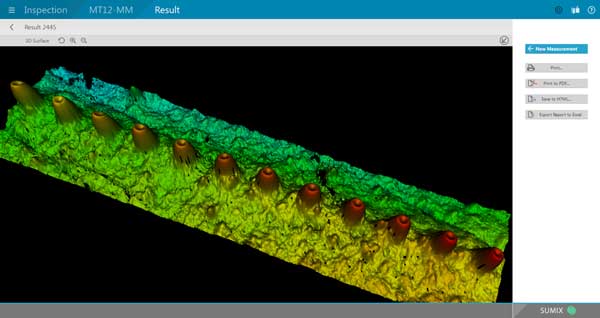
image from SUMIX
showing protruding fibers in MPO connector
More Than “Single” Mode?
Q: We're now using SM fibre so it looks like we don't
need mandrels in the Ref Lead at the Light Source. The
info I have is that we need to make a couple of air coils 35mm
to 50mm in diameter. Why?
A: When you launch from
a pigtial laser source through a connector into a reference
cable, you do have several modes being propogated. It usually
takes 100m or so for the second or third order modes to
attenuate. So the coil causes them to be attenuated by the
stress enough to no longer be significant - it’s a mode filter
just like MM. If you do not do this, you will measure higher
loss in the fiber and at connections near the source. Since most
SM has traditionally been long distance, the effect was small or
ignorable, but with short links, it can be significant.
Followup Q: But how do we explain multiple modes in Single Mode
fibre?
A: When you get the core of the fiber down to ~5-6 times the
wavelength of the light, it no longer acts like geometric optics
(like MM fiber). Some of the light can travel outside the core
(see the note on “waveguide
dispersion”here http://www.thefoa.org/tech/ref/testing/test/CD_PMD.html).
At launch, significant amounts of power are at higher angles
creating short lived modes that are highly attenuated.
Replacing OM1 MM Fiber
Q: We are an automation system integrator in South
Africa. We have a client that has multimode 62.5/125 fibre optic
plant wide. None of the runs between components are longer than
2km. We intend to upgrade the technology from a proprietary
communication protocol to a standard ethernet protocol at 100
MHZ. The fibre to copper convertors we will be using are using
1300nm light source and have a Fibre Optic Link Budget of 12.8dB
for 62.5/125 um and 9.8dB for 50/125 um. The
client has been advised to replace the multimode 62.5/125 with
multimode 50/125 cabling and we need to know if this is really a
requirement.
A: Do you know how old
the fiber is? It should be what we called FDDI grade 62.5/125
fiber with a loss of ~1dB/km and a bandwidth of 500MHz-km
at 1300nm. A 2km link should have a loss of 2dB for the fiber
and ~0.5dB/connection - well under the power budget of the link.
100Mb/s Ethernet variants were designed for 2km or more on this
fiber. There is no reason to upgrade at this time, 50/125 fiber
would not be needed until Gigabit Ethernet was desired.
Bi-Directional OTDR Testing
Q: Should the testing be done with the same piece
of equipment from both ends then merge the results or does that
not matter - can you use traces from two OTDRs as long as the
test equipment is compatible and settings are adjusted properly.
A: Yes, you should use
the same test set from each end but this way - take a trace,
disconnect the OTDR from the launch cable and go to the far end
of the receive cable and connect it there to take the second
trace. The usual way people do bi-directional tests is to
disconnect the launch cable and take it to the far end and shoot
back up, often not using a receive cable at all, figuring they
get the far end connector on the second test. But when you
disconnect the launch cable (and/or the receive cable) you lose
the connection you want to test in the other direction! As for
using the same OTDR, every OTDR is different and the results you
get may be significantly different, esp. if they are not
calibrated recently - and few OTDRs are ever calibrated.
Passive
OLANs in Hotels And Resorts
Q: Are passive OLANs a good choice for hotels or
resorts?
A: Passive Optical LANs
are enterprise networks based on fiber to the home (FTTH)
technology not Ethernet over structured cabling. The FTTH
network is usually using GPON standard equipment over one
singlemode fiber with passive optical splitters that provides
basic Level 1 and 2 network functionality. This is not Ethernet
but carries Ethernet over the GPON protocols at 2.5G downstream
and 1.25G upstream.
Passive OLANs offer several advantages over conventional
Ethernet switches and structured cabling, including much less
cost (~50% capital expense and ~20% operating expense),
much lower space requirements (see the link to the library
photos below and note the two racks of equipment that support
4000 drops), longer distance requirements (to 20km), easy
expansion (these are systems designed for hundreds of thousands
of users) and easy management (when you have hundreds of
thousands of users, that’s important.)
For hotels, convention centers and similar facilities, the ease
of upgrading to a passive OLAN is a big advantage - one fiber
goes from the computer room to a splitter where it can serve 32
switches of 4 ports each. That’s right, one fiber can support
128 users! It can support anything that a network can - wireless
access points, security cameras, secure entry systems, VoIP
phones or POTS phones - anything that will run over a
conventional network.
Calibrating
An OLTS
Q: I have a question about the OLTS - do you have to
recalibrate it every day ?
A: Any optical loss
test set needs to be calibrated for “0dB” whenever anything
changes - the launch cable - source output - or even every few
tests to ensure the connector is clean and undamaged - plus they
wear out. See 5
different Ways To Test Fiber Optic Cables.
Insertion
Loss
Q: I have not been able to find a good definition of
“optical insertion loss” or “insertion loss” or “optical loss.”
A: Insertion loss was
the term originally used for the loss of a connector tested by a
manufacturer. They would set up a source and length of fiber
connected to a meter, measure power, insert a pair of connectors
and measure the loss. Since it was an inserted connection, it
became known as insertion loss.
Over time, the term insertion loss became more widely used to
contrast with the loss measured by the OTDR, an indirect
measurement using backscatter that may not agree with the loss
with a light source and power meter.
Insertion loss, therefore migrated to meaning a loss measured of
a cable or cable plant inserted between the launch and receive
cables attached to a light source and power meter for double
ended testing used with installed cable plants. For patch cord
testing, you do not use a receive cable attached to the power
meter but connect it directly to the cable under test, making
the test just include the one connection to the launch cable.
Two other terms often mixed up are attenuation and loss, which
are essentially the same, except when discussing a fiber. In
fibers, attenuation is often used instead of attenuation
coefficient. Attenuation is the absolute loss i dB while
attenuation coefficient is the characteristic attenuation of a
fiber expressed in dB/km.
Here is probably the best explanations: http://www.thefoa.org/tech/ref/basic/test.html
Old
Fiber
Q: We are looking at a company’s fiber network which
has been laid at various points in time over numerous
years. In this process, we are trying to identify the
changes that were made to either/both the glass fiber and the
cladding. Are there different generations of what was
industry standard in creating the fiber? For example, are
you able to identify the difference in a fiber that was laid in
1980 versus one laid today? Was the cladding the same
size/thickness etc. in 1980 as it is today or has this been
modified/improved upon over the years? In all, we are
trying to find what modifications have been over the years and
how this may improve the life of the network and its
capabilities.
A: This is a common
problem today. Many network operators are evaluating their fiber
networks for upgrades, hampered by the fact that few are
properly documented. Below is a timeline that should answer your
questions. What many network owners are doing now is testing
their cable plants - a process called Fiber
Characterization. There are contractors who do this
service.
Fiber
Tech Timeline
1976 -
First field trials, US and UK, using multimode fiber at 850nm
1980 -
First long distance networks still using multimode fiber at
850nm, planning to upgrade with wavelength-division
multiplexing at 1310nm
1984 -
singlemode fiber becomes feasible, telecom drops multimode
fiber, all future installations are singlemode - this first SM
fiber with a 9 micron core and 125 micron cladding is still
available today but with better specifications. Really early
fiber may not have good environmental protection and degrades
over time. Early speeds were 145-405Mb/s, up to 810Mb/s by the
end of the decade.
1990 -
around this time, modern fiber begins - better performance and
environmental protection. Fibers for wavelength-division
multiplexing in the 1500nm range appear allowing multiple
signals on a single fiber and fiber amplifiers allow long
spans.
1995-2000
- massive build-out of fiber backbone leads to glut of fiber -
WSJ ~2001 says 93% of all fiber is dark. Speeds grew from
1.2-10Gb/s over the 90s decade
2000-date
- massive Internet growth and mobile device growth eats up
glut of fiber and demands many times more. Dense
wavelength-division multiplexing becomes the norm. Speeds
began at 1.2/2.5Gb/s, upped to 10, 40 and are now at 100Gb/s.
So most fiber installed after 1990 has the possibility of being
used at 10Gb/s, after 2000, it’s probably OK for 40Gb, and since
2010, you are probably OK for 100G and maybe more. To
verify performance, you test each fiber for connector condition,
loss, spectral attenuation, chromatic dispersion and
polarization mode dispersion. There are test sets that will do Fiber
Characterization in basically one step.
Fusion Splicing Live Fibers
Q: Is it safe to fusion splice a live fiber, or is
there a chance that
the light from the arc will damage the detectors in the modules
at the end (20km-rated SM for us).
A: I have never heard of
this being a problem. The amount of light coupled into the fiber
from the splicing would be very small compared to a properly
coupled laser. When a cable is broken you might be splicing the
fibers that are live without knowing which are live and not
caring. On your newer splicers this is not a problem. On the
older splicers with the LID system you would have to reduce the
power to get a good splice which they would do by putting a bend
in the Fiber.
Duplex
Communications Over One Fiber
Q: Is true duplex over a single fiber possible, or is
more like a shared time-domain technique in a quasi-duplex mode?
I would guess that true duplex would lead to interference
problems.
A. Bidirectional links
are widely used - that’s how FTTH PONs work. They use splitters
to combine/split the signals and one wavelength downstream and
another upstream. See Fiber
Optic Datalinks and for FTTH FTTH
Architectures.
Using
Hybrid 2.5-1.25mm Connector Mating Adapters
Q. Can I use the hybrid 2.5-1.25mm adapters for
connecting SC connectors to LCs or MU connectors. It would make
testing much more convenient.
A: We do not recommend
them for most uses, especially testing, as they can be highly
unreliable. Reserve them for emergencies and use hybrid patch
cords instead.
Test MM Fiber @ 1300nm?
Q:
What is your opinion about the need for testing at 1300
nm on OM3 and OM4 fiber especially now that bend insensitive
multimode fiber is taking over?
A: It’s
unnecessary and costly. It’s rooted in the FDDI/100M days 25
years ago when 1300 LEDs were used and is now obsolete. The
only actual uses at 1300nm I know are the extremely rare
systems using 1310 lasers which may be standards but simply
don’t seem to ever be used. As you say, BI fiber makes the
issue of finding stresses moot.
Fiber In Service Loops
Q: We designing a rural utility system that will be
expanded to FTTH (or FTTR - fiber to the ranch in this case).
We're wondering how much excess fiber in service loops to add.
One software package is asking for 12% but that seems excess.
A: I
have typically seen 100 feet on straight through boxes
(reserves), 35-50 feet on cut ends for splicing and anywhere
from 15-25 feet at the premise depending on how much is
required for the termination device, positioning, etc. When
rough estimating we have typically used 10% over linear
distance.
Maintenance of Fiber Networks
Q: Can you guide me how to prepare Optical Fiber
Cable Annual Maintenance Proposal?
A: Basically, the
network needs to be installed properly, fully tested and
everything carefully documented. Then no routine maintenance
is required. Most problems with fiber optic networks occurs
when techs are working with it, e.g. damaging cables or
getting connectors dirty when testing, so leaving it alone is
the best plan.
Electronic transmission equipment can be tested anytime to
ensure proper data transmission, but that does not involve
accessing the fiber.
We have several things which may be of help:
You Tube Video: FOA
Lecture 39 Maintaining Fiber Optic Networks
Web page: Maintenance
I have 4 questions about OTDRs:
Q: What is dynamic range I read many time but
can’t understand yet, whether it is a range of losses can be
measured by OTDR for example if an OTDR has 45 dB dynamic range,
it can read the losses of point up to 45 dB or what it means.
A: I do not believe there is a standard definition of
dynamic range, but it is generally accepted to be the highest
loss of the longest cable where you can see the end of the
cable. That usually means using the longest test pulse and most
averaging and assuming the end of the cable has a
significant reflection.
Q: What is dead zone is it fixed in meters mean an
OTDR cannot measure up to initial 5, 10 or 20 meter
A: The dead zone is a function of the pulse width and
speed of the OTDR amplifier. For most OTDRs it’s about 2-3 times
the test pulse width.
Q: What Type of settings needed before launching a
test
A: See FOA
Lecture 18: OTDR Setup or the section "Modifying OTDR
Setup Parameters For Best Test Results” in
OTDR
testing. A: Basically you set up wavelength(s), test pulse
width (long enough to reach end of cable but short enough for
best resolution), index of refraction or group velocity (a
function of the fiber type and wavelength) and the number of
averages (enough to mitigate noise but not take too long)
Q: Reading a test with 1310nm and 1550nm - why values
different for a same length of fiber.
A: The attenuation of the fiber will be different at
each wavelength and the index of refraction which is different
at each wavelength causes a difference in length. The OTDR
measures length by measuring time and then multiplying that by
the speed of light in the fiber (which is the inverse of the
index of refraction.)
The FOA page "Frequently
Asked Questions About OTDRs" answers these
questions and more.
Getting
Old Cables Out Of Conduit
Q: How do you get old cables out of a conduit when
they are stuck?
A: Usually we are concerned about reducing friction
when pulling cables through conduit, but sometimes you need to
get them out. Here
is a page from American Polywater the leading lubricant
company with advice on the subject.
Manufacturing
Guide?
Q: Is there a guide published by FOA that provides
insight as to the process of fiber optic manufacturing? It's my
understanding that the guide stresses quality and controls to
ensure performance and reduce product loss?
A: We do have a guide
for manufacturers. It is mostly aimed at communications systems
and components manufacture. Here
is a link to download it.
How
Long Does Termination Take?
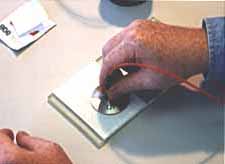
FOA received a request from a consultant recently wondering if
we had information on the termination times for fiber optic
cables. After some looking in our archives, we realized we had a
document online that compared times for various fiber optic
termination processes. The paper was written after several FOA
instructors did a comprehensive time and motion study on
termination processes. The document is about 15 years old but
still relevant.
You
can read it here in the FOA Online Guide.
Testing
Connectors (From A Patchcord Maker)
Q: What are the chief defining standard(s) that
specifies connector and assembly IL (insertion loss) and RL
(return loss or reflectance) for both SM and MM fiber?
A: The description on
our Guide is here: http://www.thefoa.org/tech/ref/testing/test/conntest.html
FOTP-34 covers connector testing as a qualification test
for the type of connector - basically a "destructive" test for
connector manufacturers.
Reflectance is described on that page and here also: http://www.thefoa.org/tech/ref/testing/test/reflectance.html
Testing an assembly like a patchcord is covered under
FOTP-107 http://www.thefoa.org/tech/ref/testing/test/FOTP-171.html
Basic
Tests For Fiber Optic Cable Plants
Q: I did some research and I noticed that there is a
bunch of tests that can be done to fiber optics and I was
wondering if there is a list of primary tests that can be done
as a basic test.
A: Fiber optic testing
does have a hierarchy of tests.
- At
the top of the list is "insertion loss" testing which uses a
light source and power meter to test the fibers in the
same way that a communications system transmits over the
fiber. It is a simple test and the equipment needed is
inexpensive.
- Techs
will also use a microscope to inspect the fiber optic
connectors for dirt and damage, a big issue for fiber.
- The
instrument called an "OTDR" takes a snapshot of the fiber
using a technique like radar. Most outside plant cables are
tested with an OTDR and the data ( the snapshots are called
"traces") stored for future reference. OTDRs are more
expensive and require more training to use properly.
Here is a
link to a page on the FOA Guide site that explains the
technical,details: http://thefoa.org/tech/ref/testing/test/OFSTP-14.html
FOA also has information just for users of fiber optic networks,
see http://thefoa.org/tech/guides/UG3.pdf
How
to Clean POF (plastic optical fiber)
Q: I
heard that plastic fibres such as PMMA can suffer damage from
cleaning from an alcohol solution. Are there alternate cleaning
solutions available for these types of fibres."
A: You can use a 10/90
mix of isopropyl alcohol/water. Typically use with a lint
free swab. (from out POF consultants)
Testing
Bare Fibers With OTDR
Q: We are starting to test some OPGW cables. We have an
OTDR but we don’t find some reusable connectors. If we have to
test an OPGW with 48 fibres, we can’t set up 48 SC connectors!
Are there some reusable connectors in the commerce?
A: I assume you mean you
need to test with a bare fiber on the OPGW. For testing bare
fiber, use a splice, not a connector. Have a long pigtail on the
OTDR as a launch cable, long enough for the test pulse to
settle, say 100-500m, then use a splice for a temporary
connection. You can fusion splice the fibers then cut the splice
out or use a removable splice like the Corning Camsplice
(http://catalog.corning.com/opcomm/en-US/catalog/ProductDetails.aspx?cid=&pid=17929&vid=18219)
If you use a mechanical splice, you need a high quality cleaver
just like with fusion splicing and after several uses, you need
to add more index matching gel or liquid - mineral oil works OK.
See
the FOA page on Testing
Bare Fiber.
Is A Flashlight Test Adequate?
Q:
I contracted a firm to install an OM3 of 200 meters. On
one end I have an SFP 1000SX ,on the other a 1000SX
converter from optical to UTP. We made pings but they never
reached, and I didn’t see the laser at the extreme of the fiber.
They promised me to send me the certification they supposely
made ,though they assured me the fiber is ok, because WITH
A FLASHLIGHT THEY SENT WHITE LIGHT FROM ONE SIDE TO THE OTHER
AND IT WAS VISIBLE. I saw the light too, and I thought the
culprit was my switch or my SFP. I want to know: is this a good
demonstration that the fiber is ok?
A: A visual continuity
test is not adequate - your eye is not calibrated! The power of
the lamp is unimportant as each eye’s sensitivity is different.
And your eye probably cannot see the light from a 850nm VCSEL
source - most people’s eyes are not sensitive at that infrared
wavelength. The installer should have tested the link with a
light source and power meter (http://www.thefoa.org/tech/ref/testing/test/OFSTP-14.html)
and given you the loss in dB. The connectors should also be
inspected with a microscope to ensure proper polishing and
cleanliness
(http://www.thefoa.org/tech/ref/testing/test/scope.html). If the
SFP output is -6dBm, what is the power at the receiver?
1000base-SX is supposed to work with 4.5dB loss (see
http://www.thefoa.org/tech/Linkspec.htm). The fiber loss should
be ~0.6 dB, so you must have >4dB connector losses! That says
bad installation! The 1000SX link should work over 200m if the
fiber has been properly installed.
Older Fiber?
Q: I have some 62.5 mm and sm inside fiber plant over
20 years old. When is a good time to upgrade?
A: When you need to or
have to. If it's working OK, there is no need to upgrade!
"Connector Loss" or "Connection
Loss"
Q: I have always counted the loss of a connector as .75
dB (568B-3) and 1.5 for a mated pair. Is that correct?
A: While the industry
always says "connector" loss, it is actually "connection" loss.
As we explain in the page on termination and splicing (http://www.thefoa.org/tech/ref/basic/term.html)
When we say "connector" loss, we really mean "connection" loss -
the loss of a mated pair of connectors, expressed in "dB." Thus,
testing connectors requires mating them to reference connectors
which must be high quality connectors themselves to not
adversely affect the measured loss when mated to an unknown
connector. This is an important point often not fully
explained. In order to measure the loss of the connectors
you must mate them to a similar, known good, connector. When a
connector being tested is mated to several different connectors,
it may have different losses, because those losses are dependent
on the reference connector it is mated to."
The
TIA spec of 0.75dB is for a mated pair of connectors. If you
have been passing connectors tested @ 1.5dB loss....you may have
some very bad connectors in your cabling!
Microscope
Magnification (11/13)
Q: I am doing a lot of fiber optic jumpers for control
systems, either single mode or multimode. I want to get a
scope to inspect the ends after I clean them would you recommend
a 200X, 400X handheld or one similar to a Noyes OFS 300
200C?
A: We prefer to use
lower magnification and have a wider view so I can see more of
the ferrule to determine its condition. You can see the fiber
effectively at 100X but 200X may be better. 400X may be too much
for most tasks like inspecting for cleanliness, but may be good
if you are polishing SM for good reflectance. We've used the
Westover units for years because they offer two different
methods of illumination - direct and at an angle. If you are
doing a lot of patchcords, I recommend a video microscope. I've
used the Noyes unit that interfaces to a PC to create the FOA
Microscope Inspection YouTube video here: http://www.youtube.com/watch?v=IyumH8CiUPQ&feature=youtu.be
and it works well.
Recycling Cabling
Q: Who can I contact regarding recycling cable I am
removing from a building?
A: Here are some people
who say they recycle fiber optic cable or at least know how to
do it:
http://www.scottrecycling.com/complete.html
http://www.scrapmonster.com/selloffer/fiber-optic-cable/10400
http://www.dnvkema.com/services/ces/hse/recycling/recycling-cables.aspx
http://tmscrapmetals.com/Recycling.html
Tech
Hint: Did You Know You Have A Fiber Optic Tester In Your
Pocket?
Yes!
That old mobile phone has a camera which may be sensitive to
infrared light - lots more than your eye - and can detect
light in an optical fiber or from a transmitter. Chris
Hillyer,CFOT/CFOS/I, Master Instructor, Northern California
Sound & Communication JATC sent us some photos showing how
this works. See below
or the video
now on YouTube. Update: You should check out your old
cell phones before you recycle them. We've found older models
use sensors which are better at infrared than the newer ones
which take better pictures. This is a good use for your old
cell phones hiding in the drawer!
Fiber
Cleaning
This is a topic we keep reminding everybody about, and here is
why:
From
a contrator in the Middle East: Here some samples of the
connectors for SM fiber already installed in the system we were
testing.

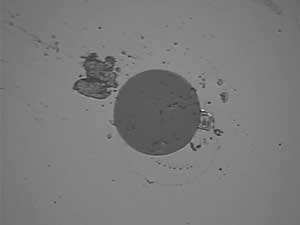
As
you can see, the dirt is large compared to the size of the fiber
(dark gray), and the core (not visible here) is only 9/125 of
the overall diameter of the fiber!
Clean
Every Connector - A Lesson We Learned From Creating Lessons
In creating
the fiber
characterization
curriculum, we got inputs from many experienced techs about the
testing requirements. Everyone we talked to made a big point
about cleaning and inspecting connectors before testing. Dirty
connectors are a major problem with errors in testing. We've
also seen that many installers think that if a connector,
especially new connectors, has a "dust cap" on the connector, it
does not need cleaning. WRONG!
The common name for the plastic caps on connector ferrules is
"dust cap" and a friend says they
are called "dust caps" because they are full of dust.
Those plastic caps are made by the millions, popped out of
plastic molding machines into barrels and stored until put into
plastic bags. Whenever you remove one of them, clean the
connector before testing or connecting it.
More on connector cleaning is here and here.
More
on cleaning. See Product
News below for links to vendors of fiber cleaning products.
What
You Need To Know About Fiber Optic Cleaning And More
Ed
Forrest, one of the industry experts on cleaning fiber optic
connectors, retired about a year ago. We encouraged him to put
down on paper what he knew about fiber cleaning and he took our
advice. He's now created 4 books on cleaning topics that cover
just about everything you need to know. And he added another
volume that's also important - maintaining fusion splicers. We
recommend these books highly.
How to Precision Clean All
Fiber Optic Connections
Understanding Cross-Contamination Points on Fiber Optic
Inspection & Test Equipment
Maintaining a Fiber Optic Fusion Splicer
Comparison Study of Precision Cleaning Methods for All Fiber
Optic Connection
Whitepaper: The Significance to Optical Internconnect:
Properly Cleaning a Fiber Optic Connection
Information on Ed's books is at http://fiberopticprecisioncleaning.com/available-books-whitepapers/.
See
news about Fiber Optic Cleaning Videos on YouTube by ITW
Chemtronics below.
Fiber Optic Cleaning Videos on YouTube
See news about Fiber Optic Cleaning Videos on YouTube by ITW
Chemtronics three fiber optic cleaning videos on YouTUbe
covering Dry
Cleaning, Wet-Dry
Method, FiberWash
and Combination
Cleaning. They are good explanations of cleaning processes
- the Wet-Dry is especially interesting.
Measurement
Uncertainty: Everyone testing fiber optics should understand
that every measurement has some uncertainty - whether you are
measuring loss, length, wavelength, power, etc. Knowing that
uncertainty is very important to interpreting the measurement.
It's worthwhile to read and understand the issue of measurement
accuracy covered in this
page of the FOA Online Fiber Optic Reference Guide.
RETURN
TO INDEX
Worth
Reading or Watching:
Sign
up at the FOA Pinterest
board 
FOA
"Quickstart Guides"
In our
continuing quest to help people understand how to test fiber
optic cable plants and communications systems, we've created two
more "QuickStart Guides to Fiber Optic Testing." They are
simple, step-by-step guides on how to test fiber optic cable
plants, patchcords or single cables using insertion loss or OTDR
techniques and optical power from transceivers. It's as
straightforward as it can get - what equipment do you need, what
are the procedures for testing, options in implementing the
test, measurement errors and documenting the results.
It can't get much simpler.
Send anybody you know who needs to know about fiber optic
testing here to learn how it's done in a few minutes.
Testing
Fiber Optic Cable Plants And Patchcords
Testing
Fiber Optic Cable Plants With An OTDR
Measuring
Optical Power In Communications Systems
Like
Crossword Puzzles? Here's Some On Fiber Optics
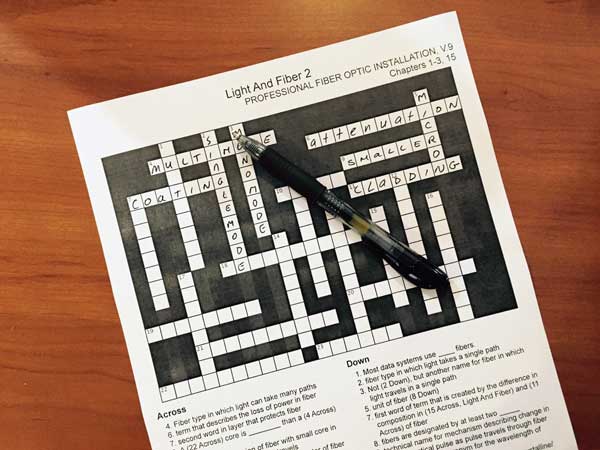
Do you like
crossword puzzles? How about one on fiber optics - or maybe a
half-dozen of them? FOA Master Instructor Eric Pearson of Pearson
Technologies has created a series of crossword puzzles on
fiber optics that are keyed to the FOA CFOT reference materials
and his book Professional
Fiber Optic Installation, v.9. You can have fun and
study fiber optics at the same time!
This months crossword puzzle is on "Optoelectronics and
Splicing" - Download
the crossword puzzle on "Optoelectronics
and Splicing."
If you
missed the earlier puzzles, here they are:
Download
the PDF file of the crossword on "Light and Fiber".
Download
the PDF file of the crossword puzzle on "Cables".
Download
the crossword on "Connectors
& Splices."
Older
Fiber, Do You Know How Good It Is?
There's
millions of miles of long distance fiber installed around the
world and most of it likely to see an upgrade of the systems
operating on it, probably in the near future. Twenty years ago,
most of it was probably running at ~1Gb/s, ten years ago it was
probably 2.5 Gb/s, recently it was likely to be 10Gb/s but now
many are being considered for 100Gb/s or beyond. Can the fiber
support such speeds? Can it be "repaired" or "modified" to make
it possible to use it at higher speeds? If you own that fiber,
can you say what it is worth without knowing its future upgrade
capability.
In order to know the potential for upgrades on your cable plant,
you need to test it. This process involves a number of tests and
is called "fiber characterization." Greg Stearns of TTP-US, an
FOA Corporate Member, performs these tests and has written a
short article on why you need to characterize fiber and how its
done. Read about fiber characterization from someone who does it
often and can explain it well.
Download
the paper here (PDF, 80kB).
Demystifying
Singlemode Fiber Types
Singlemode
fiber has a lot of names and users are confused by the different
names depending on the standards organization you refer to IEC,
ITU or TIA designation. Most widely used are the ITU G65X
designations but even there we find many designations. Shaun
Trezise of M2FX has posted a simple explanation on the company
blog that helps explain the different types and where they are
used. Read
more on the M2FX blog
There is a cross
reference to the IEC, ITU and TIA designations on the FOA
Guide.
EXFO
Offers Super Posters And More

EXFO offers some super posters, guides and books. The FTTx and
OTDR posters are really useful! Look
at the whole selection here.
Getting Cables Out Of Conduit
Usually we are concerned about reducing friction when pulling
cables through conduit, but sometimes you need to get them out.
Here
is a page from American Polywater the leading lubricant
company with advice on the subject.
What Is The FOA?
Hear FOA President Jim Hayes tell the FOA Story in a 2-part
interview by Sound & Video Contractor Contributing Editor
Bennett Liles. It tells about the FOA history, goals and
achievements.
Part 1: http://svconline.com/podcasts/audio/fiber_optic_association_part1/index.html.
Part 2 http://svconline.com/podcasts/audio/inside-fiber-optic-association2-0924/index.html.
What
Happens To Old Fibers?
In a recent web search, we found this article from Corning,
reprinted from a IWCS presentation in 1995. It discusses
extensive tests on a 1984 cable installed in the northern US to
see how it had degraded in almost 10 years. It is interesting to
see how the fiber survived OSP exposure. Read
it here.
Australia's
Standard Is Comprehensive Guide To Customer Cabling (Get your
copy free)
In
answering a recent technical questino, Trevor Conquest in
Australia pointed to the Australian Standard "Installation
Requirements For Customer Cabling." When we checked, it is on
the web and can be downloaded. It's a big book - 220 pages -
full of details for fiber and copper installations. We recommend
you download
yourself a copy - go here.
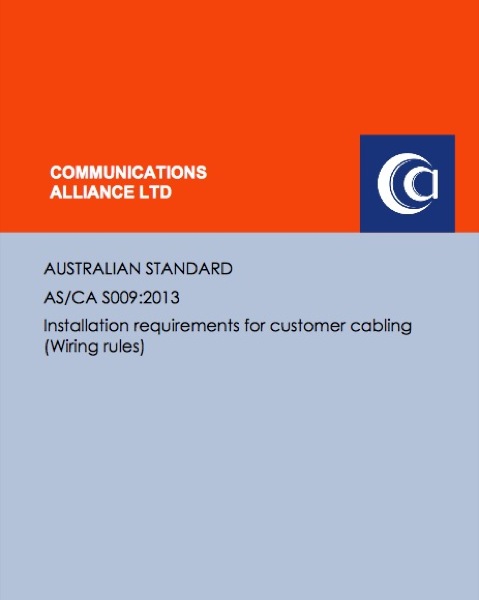
Demystify
fiber inspection probe technical specifications -
From EXFO
The
intent of this application note is to promote a better
understanding of video inspection probe specifications and
features. Properly understanding the key specifications
and features will greatly facilitate the decision process
involved in acquiring such devices. Understanding the key
aspects of fiber inspection probes will also help users
understand how fiber inspection probes operate, thus
enabling them to maximize the full potential of these
devices. Read
more.
Where
In The US Do Contractors Need Licenses For Fiber Optics?
We often
get asked where in the US do contractors doing fiber optic
installations need licenses. We found a good website for that
information, the NECA -NEIS website. You might remember
NECA-EIS, as they are the partner with the FOA in the NECA/FOA
301 Fiber Optic Installation Standard. NECA is the National
Electrical Contractors Association and NEIS stands for National
Electrical Installation Standards. They have a very easy to use
map and table that gives you data on every state in the US, so
mark these pages for future reference.
NECA/NEIS
http://www.neca-neis.org
(See “State Regulations”)
http://www.neca-neis.org/state/index.cfm?fa=state_regs
(all electrical licensing)
Low Voltage: http://www.neca-neis.org/state/index.cfm?fa=specialty_licensing
How Is
Fiber Manufactured?
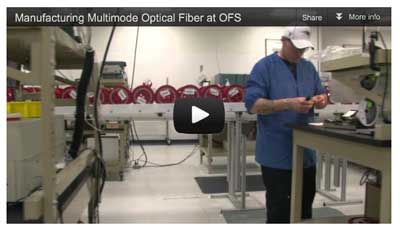
OFS invites you on a tour of their multimode fiber manufacturing
facilities in this new 5-minute video. You will see their highly
automated manufacturing operation in Sturbridge, Mass.,
including their patented MCVD preform fabrication process to
fiber draw and final product testing. With a technological
heritage dating back to AT&T and Bell Labs, OFS has been
manufacturing high-quality multimode fiber since 1981.
Watch
the video here.
Benchmarking
Fusion Splicing And Selecting Singlemode Fiber
We've been asked many times "How long does it take to splice a
cable?" It's not a simple answer as it varies with the number of
fibers in the cable and the work setup, including whether one or
two techs are working at a job site. FOA Master Instructor Joe
Botha of Triple Play in South Africa did his own analysis based
on decades of experience both splicing cables and teaching
others how to do it properly. This is one of the best analyses
we have seen because Joe includes prep times as well as splicing
times and differentiates between one tech and two techs working
together. He adds some other tips on fusion splicing too. This
should be mandatory reading for every tech and given to every
student! Here
is Joe's splicing analysis.
Joe also has an excellent writeup on how
to choose singlemode fiber that helps understanding
the different types of G.6xx fiber. Read
it here.
And you will want to read Joe's report on splicing
different types of SM fiber, including bend-insensitive
(G.657) fiber. Read
it here.
Free
- Mike Holt's Explanation Of The US National Electrical Code
(NEC) For Communications Cables
Mike Holt
is the acknowledged expert of the US National Electrical Code
(NEC). His books and seminars are highly praised for their
ability to make a very complicated standard (that is in fact
Code - law - in most areas of the US) easily understood. Part of
the appeal is Mike's great drawings that make understanding so
much easier. Mike makes Chapter 8 of his book available free. It
covers communications cables, telephones, LANs, CATV and CCTV,
for premises applications. Even if you live in a region or
country where the NEC is not the law, you may find this
interesting.
Download
Mike's Chapter Here.
Fiber
Optic Cleaning Videos on YouTube
ITW
Chemtronics has three fiber optic cleaning videos on  covering Dry
Cleaning, Wet-Dry
Method, FiberWash
and Combination
Cleaning. They are good explanations of cleaning processes
- the Wet-Dry is especially interesting.
covering Dry
Cleaning, Wet-Dry
Method, FiberWash
and Combination
Cleaning. They are good explanations of cleaning processes
- the Wet-Dry is especially interesting.
-
- Download
yourself a copy and read it!
-
Good
Technical Website For Installers
American
Polywater (http://www.polywater.com/)
has one of the best technical website for cable installers. Check
out their website, especially “Videos,” “Engineer’s Corner”
and “Calculators.” http://www.polywater.com/NNNBSL.pdf
Fiber
Optic Safety Poster
We've had numerous requests to reprint our guidelines
on safety when working with fiber optics, so we have
created a "Safety Poster" for you to print and post in your
classroom, worksite, etc. We suggest giving a copy to every
student and installer.
RETURN
TO INDEX
-
FOA
Tech Topics -
A
Fiber Optic Tester In Your Pocket? (See the video on
 )
)
Yes!
The camera in your old cell phone is sensitive to infrared light
- lots more than your eye - and can detect light in an optical
fiber or from a transmitter. Chris Hillyer,CFOT/CFOS/I,
Master Instructor, Northern California Sound & Communication
JATC brought this to our attention.
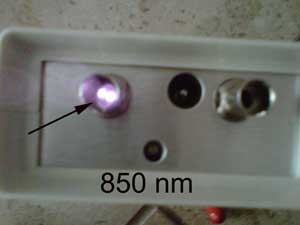
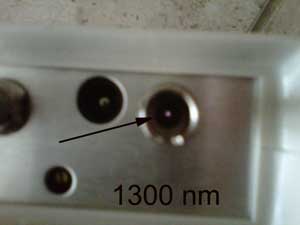
If
you have an old cell phone, try it. Our experience is that older
cell phone cameras have better sensitivity at IR wavelengths
than newer phones, so you may want to toss that old flip phone
into the toolbox.
RETURN
TO INDEX
Product
News
New
Ripley Fiber Stripper
Ripley
recently sent us some new fiber strippers to try, the Ripley
Tri-hole fiber stripper model CFS-3. It is aimed at
contractors and installers and is very reasonable prived - plus
we understand there are some introductory price specials from
some distributors.
The CFS-3 can strip fiber jackets, 900 micron buffer and 250
micron buffer for one step cable preparation.
- 1st hole strips 1.6 – 3mm Fiber Jacket to the 600-900 buffer
coating.
- 2nd hole strips the 600-900 micron buffer coating to the 250
micron coating.
- 3rd hole strips the 250 micron buffer coating to the 125
micron glass fiber.
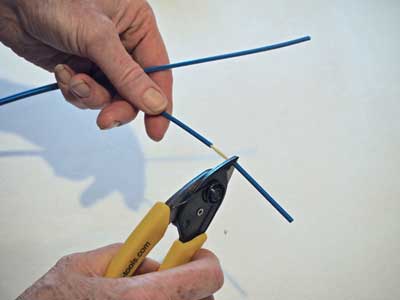
We tested
the CFS-3 on several fibers and cables and found it easy to use
and very consistent. It seemed much less sensitive to the angle
you hold it at when stripping fibers than some strippers like
this and it was very effective even stripping some older, more
brittle fibers.
Here's
more information on the Ripley CFS-3 Part #: 81300.
VIAVI
Introduces OLTS For MPO Connectors
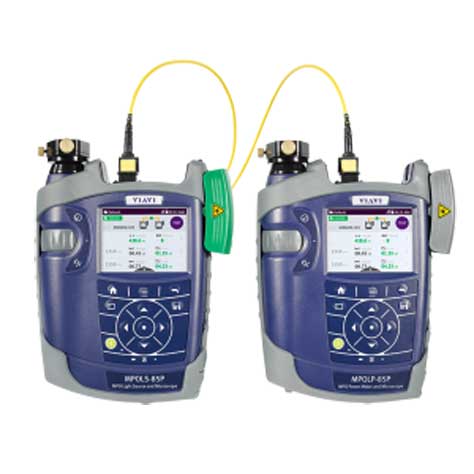
One of the biggest problems with multifiber MPO connectors is
testing. Viavi Solutions (formerly JDSU) has introduced its
SmartClass Fiber MPOLx optical loss test set, a basic test
solution for cabling systems that utilize multi-fiber MPO
connectors. The testing of parallel optics with MPO connectors
has always been difficult for regular single or dual fiber OLTS,
needing MPO to SC or LC breakout cables for testing one fiber at
a time and using the three cable “0 dB” reference method. The
MPOLx should make testing cable plants using these connectors
much easier.
The MPOLx can test for length, optical loss, polarity and
inspect fiber end-face condition - a complete cable plant test.
The ability to check polarity is important since there are
several polarity schemes used in MPO systems. The MPOLx is fast
too, delivering comprehensive test results in less than 6
seconds for all 12 fibers.
More
information on the Viavi MPOLx here.
YOKOGAWA OTDR Has Extended range, High Resolution And Multitasking
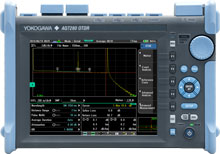
One OTDR manufacturer you don't hear as much about is YOKOGAWA
(formerly ANDO) which is too bad - they make some of the best
OTDRs, exemplified by this new model AQ7280. Need long range -
how about 50dB. High resolution - 0.6m dead zone. Like touch
screens, but for some functions want hard buttons, it's got
that. Options for VFL, microscope, light source and power meter,
etc. - it has that too.
But the unique aspect of the YOKOGAWA AQ7280 is it offers
multitasking - you can let do a trace with long averages while
you inspect connectors, make power readings, use the VFL or
other functions.
More
info on the YOKOGAWA AQ7280.
FOA
thanks Yokogawa for a gift of an OTDR to use for R&D and
teaching!
Recycling Communications Cable
FOA was
contacted by a company that recycles electronics communications
equipment and cabling. CommuniCom recycles
cable/metals/e-waste
for Telcos and CATVs. They also recycle Fiber Optic Cable and
associated Materials (the fiber scrap). And, they reclaim OSP
abandoned copper cables (abandoned from road moves or FTTx
growth). This is a huge part of our business. They do the work
(permitting/locates/labor) for free and we revenue share back
with our clients (telcos).
Contact
Steve Maginnis
smaginnis@communicominc.com
www.communicominc.com
803.371.5436 (cell)

Micro-Trenching, Cable
Removal
Nano-Trench
offers products for micro (or I guess they call it nano-)
trenching and their
website is very informative. They also have Kabel-X,
a method of extracting copper cables from old conduit. Both
websites are informative and interesting. Watch
this video on the cable removal process!
Protecting Pedestals From
Rodents
Pedestals
and underground vaults can be damaged by rodents who come up
through the base and damage cables. Uraseal "Drain N'Seal"
foam deters mice from taking up residence in your pedestals. They
have some good videos on using their product.
Used
Test Equipment – Buy or Sell
http://www.testequipmentconnection.com/
Have
you read the FOA
pages on cleaning?
- RETURN
TO INDEX
FTTH
Notes:
- Want
To Learn More About FTTx? Try our free online self-study
program at Fiber
U.
|


